#making it to the top of the byzantine empire
Explore tagged Tumblr posts
Text
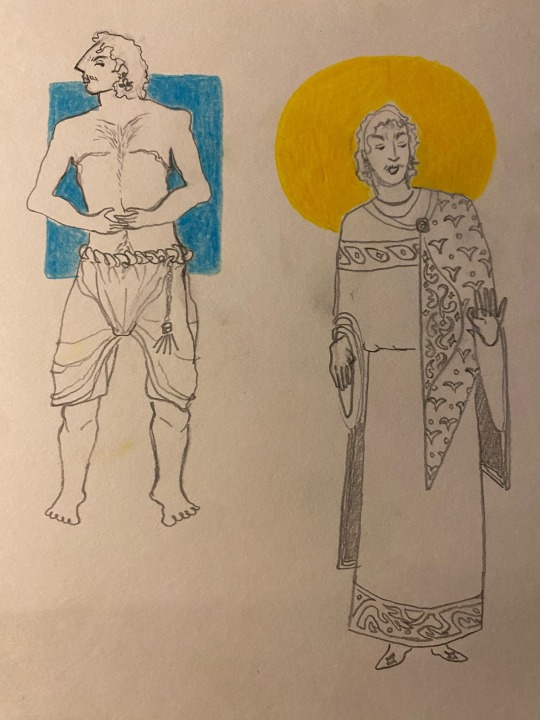
New OC just dropped — Philaretos
#trans man#transsexual#top surgery#trans artwork#byzantine#byzantine empire#oc art#once saw a post siting an article about trans people the Byzantine empire#just had to make an oc out of that#was surprisingly hard to find what Byzantine underwear looked like
3 notes
·
View notes
Text
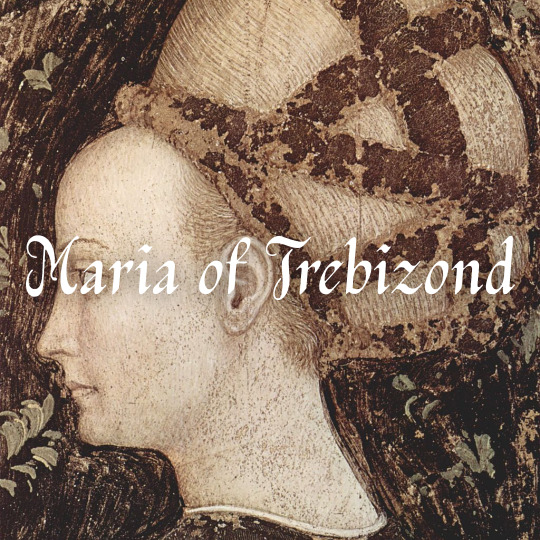
Beautiful and clever, Maria of Trebizond (c. 1404–1439) was the last crowned Byzantine empress. Active and dearly loved, she lived through the twilight years of the empire.
A homeland in peril
Maria was the daughter of Emperor Alexios IV Megas Komnenos of Trebizond and his wife, Theodora Kantakouzene. The Empire of Trebizond was a Byzantine successor state that emerged following the sack of Constantinople in 1204. Maria had four siblings and, according to all contemporary sources, was a woman of striking beauty.
Between 1426 and 1427, her father was approached by Cardinal Bessarion, who requested Maria’s hand in marriage on behalf of John VIII Palaiologos (1392–1448), the penultimate Byzantine emperor. At the time, Trebizond was facing severe challenges: external invasions, internal instability, and family rivalries. Her brother Alexander would later be forced to flee and join Maria in Constantinople. This marriage thus offered both a valuable alliance and an escape from a precarious situation.
Maria arrived in Constantinople by boat on August 29 or 30, 1427, and married John VIII in September of that year. John had been married twice before, though both unions were nominal. The emperor was a scholarly man, fond of hunting, and known to enjoy Western secular music.
The city that greeted Maria was a mere shadow of its former glory. The Byzantine Empire, much diminished in size and power, was struggling to survive.
Loved beyond measure
John and Maria’s marriage was happy, marked by affection and mutual respect. The Ecthesis Chronica records that John loved her “beyond measure” for her beauty and wisdom.
The Castilian traveler Pero Tafur described their palace life in evocative detail:
"The Emperor's Palace must have been very magnificent, but now it is in such state that both it and the city show well the evils which the people have suffered and still endure. At the entrance to the Palace, beneath certain chambers, is an open loggia of marble with stone benches round it, and stones, like tables, raised on pillars in front of them, placed end to end. Here are many books and ancient writings and histories, and on one side are gaming boards so that the Emperor's house may always be well supplied. Inside, the house is badly kept, except certain parts where the Emperor, the Empress, and attendants can live, although cramped for space. The Emperor's state is as splendid as ever, for nothing is omitted from the ancient ceremonies, but, properly regarded, he is like a Bishop without a See."
Maria went hunting with her husband or alone. She frequently rode on horseback and did so astride. The contemporary traveler Bertrandon de la Broquière once saw her as she had left the palace to dine elsewhere:
"She did not have with her more than two ladies and two or three noblemen and three such men as the Turks have to guard their wives. And when she came out from the inn a bench was brought on which she stepped and then a very handsome horse (ronchin) saddled with a richly decorated saddle was brought for her. One of the noblemen approached the bench and took the long coat which she wore and went to the other side of the horse and liſted the coat as high as he could. She then placed the foot in the stirrup, and like a man mounted the horse. He then placed the coat over her shoulders and put one of the long, pointed hats of Greece which bears along the said top three golden feathers and which fitted her very well. She seemed to me as beautiful as before. (...) She wore make up, which was unnecessary because she was young and fair-skinned. In each ear she had a hanging earring, large and flat bearing several stones, mostly rubies."
Though her political involvement was discreet, it was nonetheless real. Maria likely participated in patronage, as her name appears in several documents and on buildings. Her husband also valued her counsel.
The parting
By the 1430s, the Byzantine Empire was in crisis, with the Ottomans gaining territory steadily. In a desperate attempt to secure military aid, John VIII traveled to Italy in the winter of 1437 to negotiate a church union with the Catholic Church.
The journey and the council were grueling for John, who suffered from gout: he could ride, but not walk. In his absence, it seems that Maria and her mother-in-law, Helena Dragaš, played a role in governing the city. On one occasion, Maria even dispatched officials to update her husband on conditions in Constantinople. She also wrote him letters.
When the Patriarch Joseph died in Florence, John refused to appoint a successor until he had consulted both his mother and Maria.
During that period, Maria once again received Pero Tafur, who had recently traveled to Trebizond. She eagerly asked about her homeland. After he shared news of her family, she replied "You could not have done more if you had been of our nation."
The fatal comet
While John was still abroad, Maria fell ill. Her death was said to have been foretold by the appearance of a comet. She died on December 17, 1439, and was buried in the Pantokrator Monastery during a storm.
News of her death was withheld from John until his return to Constantinople. His advisors feared that his grief would delay their already difficult journey home.
It was thus his mother, Helena Dragaš, who broke the news upon his return to the capital in 1440—six weeks after Maria’s death. John mourned deeply and never remarried. When he died in 1448, he was buried in Maria’s tomb. He was succeeded by his brother, Constantine XI, the last Byzantine emperor.
If you enjoy this blog, consider supporting me on Ko-fi!
Further reading:
Melichar Petra, Empress of Late Byzantium
Philippides Marios, Constantine XI Dragaš Palaeologus (1404-1453): The Last Emperor of Byzantium
Tafur Pero, Travels and Adventures
#history#women in history#maria of trebizond#15th century#byzantine empire#byzantine empresses#byzantine history#eastern roman empire#historyedit#women's history#john VIII Palaiologos#herstory
76 notes
·
View notes
Photo

Theodosian Walls
The Theodosian Walls are the fortifications of Constantinople, capital of the Byzantine Empire, which were first built during the reign of Theodosius II (408-450 CE). Sometimes known as the Theodosian Long Walls, they built upon and extended earlier fortifications so that the city became impregnable to enemy sieges for 800 years. The fortifications were the largest and strongest ever built in either the ancient or medieval worlds. Resisting attacks and earthquakes over the centuries, the walls were particularly tested by Bulgar and Arab forces who sometimes laid siege to the city for years at a time. Sections of the walls can still be seen today in modern Istanbul and are the city's most impressive surviving monuments from Late Antiquity.
Making the City Safe
Although the city had benefitted from previous emperors building fortifications, especially Constantine I when he moved his capital from Rome to the east, it is Emperor Theodosius II who is most associated with Constantinople's famous city walls. It was, though, Theodosius I (r. 379-395 CE) who began the project of improving the capital's defences by building the Golden Gate of Constantinople in November 391 CE. The massive gate was over 12 metres high, had three arches, and a tower either side. It was entirely built of marble and decorated with statues and was topped with a sculpture of a chariot pulled by four elephants. The Golden Gate probably marked the start of triumphal processions which ended in the Hippodrome. Two decades later, Theodosius II was alarmed at the recent fall of Rome to the Goths in 410 CE and set about building a massive line of triple fortification walls to ensure Constantinople never followed the same fate. The man credited with supervising their construction is Theodosius' Praetorian Prefect Anthemius. The walls extended across the peninsula from the shores of the Sea of Marmara to the Golden Horn, eventually being fully completed in 439 CE and stretching some 6.5 kilometres. They expanded the enclosed area of the city by 5 square kilometres.
Continue reading...
76 notes
·
View notes
Text
Youngest Original ~ TVDU
Ch 9 - Old wounds never heal
Mikaelson!OC
Warnings: Esther being a bad mother/ANGST/self-harm, kinda (scratching)
A/N: When I first started writing this ch, I thought it would be a fun little filler ch...it did not turn out that way lol. I had a lot of feels while writing this one.
Masterlist



Some old wounds never truly heal, and bleed again at the slightest word. - George R.R. Martin
October 2010, Mystic Falls
The initial plan of leaving Klaus and Mystic Falls behind fell into the water the second their mother walked into the house. Immediately upon reuniting with her children, their mother started making order in the house.
Both Mother and Finn cut their hair, wanting to look more 'time appropriate'. To Bekah and Kassie's great pleasure, a big shopping spree was organized. Klaus wasn't so happy, since he had to pay for everything.
Kassie was overjoyed, now that her entire family was back together. She was more than happy to help Kol and Finn adjust to the 21st century. She spent hours with both of them explaining how certain machines work and how society has changed over time, and she helped them with learning modern English.
Kol was more or less familiar with most of the things she mentioned. Finn, on the other hand, was not. Back when he was daggered, the Byzantine Empire was still a thing and there was no electricity, no modern medicine, and no cars.
~
Finn was in the house library where Kassandra told him to wait for her. She was insistent on helping him assimilate to the 21st century and who was he to tell her no? Soon, he heard a click-clack sound fast approaching him. He would later learn it was because of her shoes. "I'm here! Sorry for making you wait." Kassandra said as she entered the room with many books in her arms.
She wore a black sleeveless top with a cowl neckline, blue bell-bottom jeans, and brown leather boots. Her long, dark curls fell freely down her back and a big smile was plastered on her face. Finn could see she was very excited about this.
She plopped herself right next to him, and he could see her bright eyes looking at him. Oh, how he missed her beautiful face. He missed how her eyes almost disappeared when she laughed, he missed her giggles, he missed the way she would scrunch her nose like a bunny from time to time.
"What?" She asked with furrowed brows. He chuckled and shook his head.
"It's nothing. I just...missed you, a lot." He confessed.
"Aww...I missed you too, Finn!" She said, giggled, and did the bunny nose scrunch thing. At that moment, an image of a young Kassie weaving herself through his legs and begging to be carried flashed through his mind. He patted her on the head, just like when she was little.
"Now...We have lots to talk about! Let's start with the Second Crusade!" Kassie then proceeded to tell Finn about 800 years' worth of European and world history. They were interrupted multiple times, mostly by Kol or Klaus. Kassie shooed them away every time, annoyed that they were disturbing her precious time with her eldest brother.
After Elijah, Finn was the brother she was closest to. Finn was 12 years older than her, so he always felt very protective of both her and Bekah. He was by far, the gentlest of her brothers and the quietest one in the family.
As she was folding the map of Europe she used in her presentation, Finn observed her face - her eyelashes seemed to be covered in a black substance which made them darker and her eyelids appeared to shimmer. How? He didn't know. He gently grabbed her face and turned it toward him. He studied her face with furrowed brows, trying to understand.
She seemed taken aback by this, her eyes looking curiously at him. He lifted her chin and in that moment the sunlight covered her face, making the shimmer on her eyelids more apparent. "Why do your eyelids shimmer?" He asked, eager to know.
She chuckled and grabbed his hand. "Oh, my dear Finn. It's called 'eye shadow'. It's a powder-like substance you apply to your eyelids. It comes in many different colors. The one I have now has these little crystals that make my eyes shimmer!"
She explained to him the best she could. Old Norse didn't have words for glitter or makeup. But it seems he understood what she was trying to explain. He then asked about her eyelashes and she explained what mascara did. She enjoyed his childlike curiosity.
~
After her study session with Finn, Kassandra went back to her room. There, she found Rebekah, who was rummaging through her closet. Kassie sighed softly before clearing her throat. Bekah spared her a glance but continued looking through her clothes.
"What are you doing?" Kassie asked as she took a blouse from Bekah's hand and put it back on the hanger.
"These are cute," Bekah said as she held up a pair of boots. "Can I borrow them sometime?"
"Rebekah."
Her sister sighed and jumped on her bed. Kassie followed and sat next to her sister. Bekah was playing with the sheets of the bed and some of the sunlight caught her golden heart-shaped ring, the one that matched Kassie's silver one. Kassie took hold of Bekah's hand.
"What is it?" Kassie asked softly.
"Mother is planning a ball, you know that?" Bekah said and Kassie furrowed her brows. Why was she always the last person in this family to find things out?
"Ok, and?"
Bekah gave her a look and rolled her eyes. She dramatically threw her hand in the air. "And? Well, we need some ball gowns, obviously. And you have none in your closet."
"So? We'll just go shopping. Plus, it will be a good bonding experience, seeing as we haven't spoken properly in over 90 years." Kassie remarked as she got up from the bed and started putting all the clothes back into the closet.
"Why is she even making a ball in the first place?" Kassie asked.
"I don't know. Something about family bonding and healing old wounds, I wasn't really listening." Bekah said, looking at her nails.
Kassie chuckled at her sister's snarky comment. She missed this; Rebekah was always a breath of fresh air, especially amongst their male-dominant family. She and Kassie were like two peas in a pod, you could not find one without the other. The two girls were only 14 months apart and in many ways, they thought of each other as twins who were supposed to be born together but were separated long before their creation.
"I missed you." Kassie blurted out before she could stop herself. She jumped back on the bed, grabbed Bekah's hand, and looked at her ring as she poured her heart out.
"I missed your snarky comments. I missed your fashion advice. I missed you helping me with my hair. I had no one to confide in when Klaus got on my nerves...I was alone, for decades. It was horrible, Bex." Kassie confessed tearfully.
Rebekah said nothing, for her own throat was tight and she herself was on the verge of tears. She pulled Kassie into a tight hug and they just held each other for what felt like hours. After a while, she pulled back and wiped off a tear from Kassie's cheek.
"No more crying. Now, how about that dress shopping?" Bekah suggested, trying to lighten the situation.
Kassie sniffled and smiled.

The two sisters spent the entire afternoon shopping for the perfect ball gown. Once they settled on the ones they liked, they drove back home. Then, Finn informed them that Mother wanted to speak with Kassandra. In private.
Kassie was surprised but surmised it wasn't that odd. Her mother hadn't seen her in over 1000 years; it was natural a mother wanted to spend some time alone with her youngest child. She made her way to Mother's room. She knocked and slowly opened the door. She was met with the sight of her mother, now with shorter hair and dressed in modern clothing, standing over a table.
There was a smell in the air; something herbal, Kassie concluded. She stood there, waiting for her mother to speak. "Mother?" She said after a while. Her mother turned, and Kassie saw she was holding a bundle of dried herbs.
"It's just sage. For privacy, so that the others can't eavesdrop." Mother said calmly.
She gestured for Kassie to sit down and she did. On one hand, Kassie was happy that her entire family was back together; it's just, that she never expected her mother to return. In all honesty, she was fine with her mother being dead. Yes, she was aware of how horrible that sounded. But in her defense, her mother conspired with their father to kill Kassie and her siblings, and then Mother turned them into blood-sucking monsters. No one could blame her for having a difficult relationship with her parents.
"Why did you call me here?" Kassie asked as Mother sat down next to her.
"I haven't seen my precious little girl in over 10 centuries. I just wanted to talk to you a bit about your life. Is that such a crime?" Mother said and then asked how the dress shopping went.
"Um...fine. I chose a blue one. Bex chose a green one." Kassie replied awkwardly.
"Good, good. And who will you bring to the dance?" Mother inquired.
Kassie gave her a confused look.
"You know... as your date, as the people now say."
"Oh...Um, no one."
"No one? Kassandra, darling, you're a beautiful girl! It would be such a shame for you to be all alone." Mother commented, gently touching her knee. Kassie squirmed slightly in her seat.
"Mother, I've been in this place for only a month. I don't know anyone good enough to invite them as my date." Kassie retorted.
"That's because you guard your heart like a fortress and let no one in. Daughter, it's been 900 years. Let him go." Mother told her gently.
Kassandra looked at her mother in disbelief. How could she say such a thing? Kassie felt confused beyond belief. She sighed and ran a hand through her hair.
"Excuse me? Let him go? The love of my life? My husband? You want me to let him go? Are...Do you hear yourself?"
"Kassandra, dear...You've been pining after him for centuries. You've been holding on to this false sense of hope and nothing good came of it. Get over him and continue living your life."
"...Get over him? Are you mad!? Hope is the only thing that has kept me going. How could you say such a thing?"
Her mother gave her a look of pity and Kassie could not bear it. She got up and paced across the room. "So this is why you called me here? To open old wounds and hurt me even more?" She accused, feeling rage coil inside her like an angry viper.
"Of course not! As your mother all I want is for you to be happy! You've wasted centuries searching for him and to no avail. You need to let him go." Mother said as she grabbed Kassie's hand.
"If you truly were my mother, you would know how much I loved him and how much he meant to me. There is no peace, no happiness without him. I lost him centuries ago, but I still have faith. I know he will come back to me." She rebuked tearfully, pulling away from her mother.
She glared at her mother but decided it was not worth arguing anymore. She stormed out of the stuffy room and slammed the door behind her.
~
Elijah was in his study when a loud bang echoed through the house. Suspecting Klaus and Kol or even Rebekah broke something, he walked out into the hallway to inspect what happened. To his surprise, he saw Kassandra storming down the stairs and out of the house.
"Kassandra!" He called for her but she ignored him. He followed her outside and kept calling her. She got inside her car and he sped over to her before she could take off. He knocked on the window. She sighed but still lowered it.
"Little dove, what happened? What upset you?" He asked, genuinely concerned for his little girl.
"Get in the car." She commanded. "I said. Get. In. The. Car." She repeated herself after she noticed his silent confusion.
He did as she said, not wanting to upset her further. She wanted to talk, or she wouldn't have invited him. Once he was in the car, she hit the pedal and drove them deep into the forest surrounding Mystic Falls.
~
Multiple times throughout the drive, he tried asking her what happened but she did not answer. A silent fury was brewing inside her, one that would not be silent for long. Tears kept on spilling down her face, blurring her vision, and all Elijah wanted to do was take her in his arms and hold her, just like when she was a little girl. But she was grown, no matter how hard he tried to ignore that.
Shortly after crossing Wickery Bridge, she made a sudden stop in the middle of the road. Quickly unbuckling her safety belt, she opened the car door, intending to get out, but Elijah stopped her. With a soft hand, he pulled her back into her seat. Refusing to meet his eye, she kept her gaze away from him, staring through the window. Putting her hands on the steering wheel, she gripped it, needing something to ground her.
"Am I a fool?" She whispered, still not meeting his eye.
"What do you mean?" Elijah asked softly.
"Am I a fool for wanting to believe he will come back to me, and that in the end, I was not wrong in upholding my faith in him?" She clarified and Elijah knew immediately whom she was talking about.
"And why would you think such a thing?" He inquired.
She shook her head, too upset to verbalize her thoughts. Taking a deep breath, she told Elijah about her 'talk' with their mother.
"She said that I need to let him go...that I need to get over him...How-how could she say that?"
"Kassandra-"
"Ugh, why didn't she just stay dead!?" Kassie yelled, hitting the steering wheel, and stormed out of the car. Elijah followed suit.
She paced alongside the car, her hands in her hair, while she tried steadying her breathing. She was losing control, she could sense it. Soon, she would spiral. All the negative feelings she had been harboring for Klaus and now her Mother, resurfaced. Then, she screamed in frustration and kicked a nearby tree, making the entire trunk shake. Elijah was by her side in a second and grabbed her shoulders.
"Doll, listen to me. Breathe. Calm down."
"Wh-why are they hurting me?" She asked while grabbing his arms, her throat tightening. Elijah didn't seem to understand.
"M-Mother and Klaus. Why are they hurting me? Always s-saying m-mean things to me and hurting my f-feelings..." She stammered, her voice breaking.
She sounded so childlike and innocent. Elijah swallowed hard and gently took hold of her head. Kassie looked at him, her eyes wide and glossy, her face covered in tears. Her lower lips quivered as she asked "Don't they love m-me?" At that moment, she looked and sounded like a scared little girl craving validation and affection.
"Of course they do." He answered quickly.
"I know he is alive Elijah, I know he is. In my heart and in my bones I know it. If he was d-dead...I would feel it, surely. If he were dead, I would die too." She insisted and Elijah had never heard her speak with so much conviction.
Before he could respond, she removed herself from his arms. She turned around, looking up at the waning sun. God, she was angry. So, so, so angry. Vampirism only heightened her emotions, and now her rage was feeding into her bloodlust, making her hungrier than usual. Usually, she was able to keep it under control, to subdue the urge to kill and devour. But right now, Kassie could feel the grip she had on her passions slowly fading away.
In a desperate attempt to distract herself from the hunger, she started harshly scratching her bare shoulders and forearms, so hard she started drawing blood; though the wounds immediately healed. Her sharp nails pierced her skin, leaving behind a stinging sensation. Maybe if she focused on the pain, she would forget about the bloodlust.
"Kassandra, stop! Stop hurting yourself!" Elijah reprimanded with a raised voice, something he rarely did with her.
He grabbed her hands and held them tightly. She squirmed in his arms, trying to free herself but he didn't let her go. Instead, he turned her around and pulled her closer. Her back hit his chest and he wrapped his arms around her middle. She thrashed and screamed and the sounds broke Elijah's heart.
"Kassandra, please-" Elijah begged but his pleas were not heard. Kassie dug her sharp nails into his hands. He hissed in pain. If she continued like this, he would have to snap her neck. He decided he needed to reason with her, but, it was also obvious to Elijah that she had a lot of pent-up anger and it was crucial she let it all out.
Then, he pinned her up against a tree and pulled her arms behind her back. She screamed in anguish and at this point her true face was fully on display. Her long fangs were bared as she hissed in his face. Her face was twisted in anger, her red eyes stared at him.
"Kassandra, listen to me. I understand you are angry and hurt. I know, better than anyone, how it feels to lose the love of your life. But you need to calm down. This is not you. You cannot let anger control you. You are better than this."
At these words, she stopped fighting him and seemed to relax in his arms. The fangs and black veins were gone, and her blue irises reappeared. She stared at him confused.
"Lijah?" She uttered his name and just by her voice he could tell she was back to normal. Once the blindfold of rage was lifted from her eyes and she realized what happened, guilt overwhelmed her. She sank to her knees and wept as she tried apologizing.
"I'm s-sorry...I'm s-so sorry, Lijah, I-I don't know what h-happened to me." She sobbed.
"My sweet girl." He whispered as he crouched next to her and got down to her level. She threw herself in his arms. He shed a few tears himself.
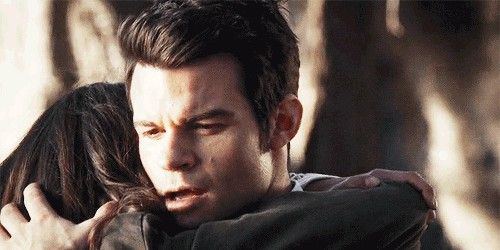
"Where's Elijah?" Klaus asked as he walked into the living room. He was out for most of the day and when he visited Elijah's study he was not there. Kassandra was also nowhere to be found.
"He went after Kassie," Rebekah informed him as she filed her nails.
"Went after her? Well, where is she? What happened?" Klaus asked.
"Something happened with Kassie. I didn't see anything but I heard Elijah calling for her and then they stormed out of the house. I'm assuming it had something to do with her talk with Mother." Rebekah replied.
Klaus hummed. What could their Mother say to hurt Kassie so much she stormed out of the house? There was only one thing that came to mind. He needed to make sure their Mother kept quiet.
~
They were now in the car and this time, Elijah was driving. She was in the passenger seat, looking out the window, her head tilted. The moon was rising and its light illuminated her tear-stricken face.
The car was silent. Neither of them spoke. Guilt and shame washed over her in continuous waves as she replayed her breakdown in her mind. She hurt Elijah, her favorite brother. The one person on this Earth who was always there for her. She sank deeper into her seat, covered her face with her hand, and wept silently.
Almost like he was reading her mind, Elijah spoke up. "I'm not angry at you, Kassandra. I do not begrudge you."
She shook her head. This had nothing to do with his forgiveness because it did not matter. This was about her consciousness eating at her and her sense of shame for what she had done. His forgiveness did not make it any easier.
"I think death would've been easier than this...Cursed existence."
Elijah said nothing, but she knew he agreed.
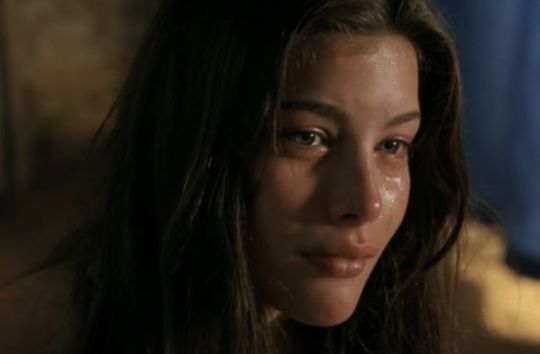
Taglist: @ashaluuler
#my girl is in the trenches#somebody save her#kassandra mikaelson#tvd oc#my original characters#tvd fanfiction#the originals fanfiction#the originals#the mikaelsons#elijah mikaelson#rebekah mikaelson#klaus mikaelson#kol mikaelson#finn mikaelson#mikaelson family
31 notes
·
View notes
Text
авантура Цанмома у Београду
avantura Canmoma u Beogradu, or, the adventure of canmom in Belgrade
it's another one of these 'travels of canmom' posts! last time we went to Gamescom in Germany. this time I went to Belgrade for a company event.
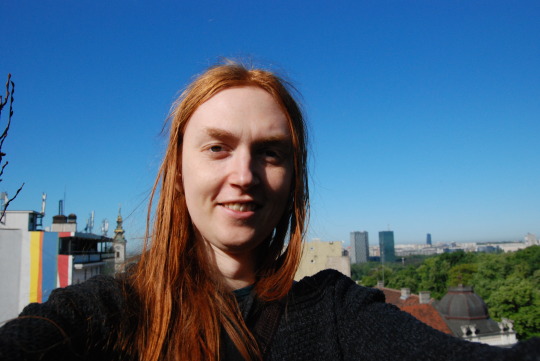
I can't actually talk that much about this one because the main thing I was doing was cooking up game pitches for what we might work on next (kind of like a game jam but just for concepts), and while that was very interesting and I learned a lot about how to get ideas across in limited time and make judgements about what videogames might sell and how long they'd take to make and such... it is however probably not something I can talk in too much detail about yet, because we might end up making these games, so I can't be like 'the theme was x and we pitched y'.
so instead I will mostly talk about Belgrade! and show some of the photos I took that don't have game developers wandering around in them.
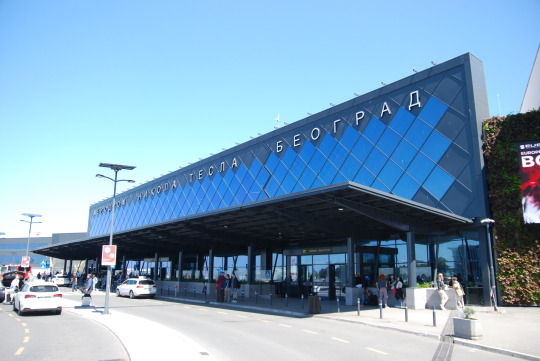
that's Nikola Tesla airport. did you know that Nikola Tesla was from modern-day Serbia (at the time, the Austrian Empire)? I didn't but I do now!
most of the week was spent in this fancy villa...
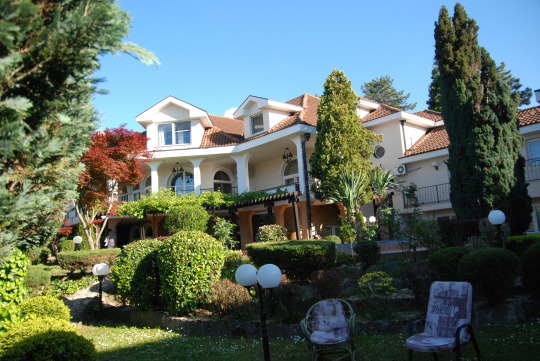
...which is called the Villa Saga Paradiso. it must once upon a time have been some stinking rich family's holiday home, because it's a super weird building, with such features as a pool table, swimming pool, tennis court, library, and even a weird kinda stage thing on the top floor. definitely full of weirdly shaped rooms and interesting old furniture, it felt kinda like a place a moomin might hole up. so here's some pics of the place.
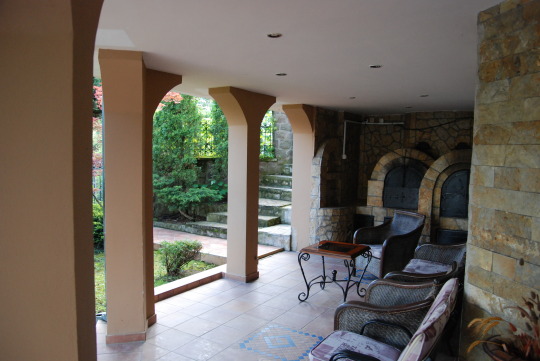

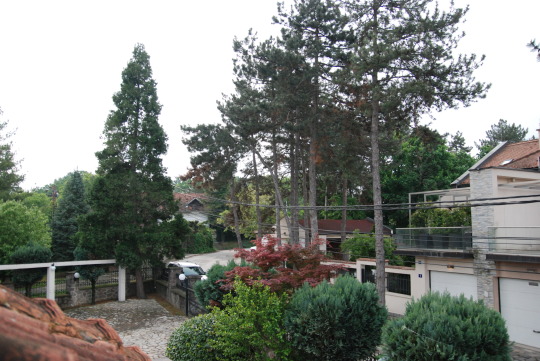
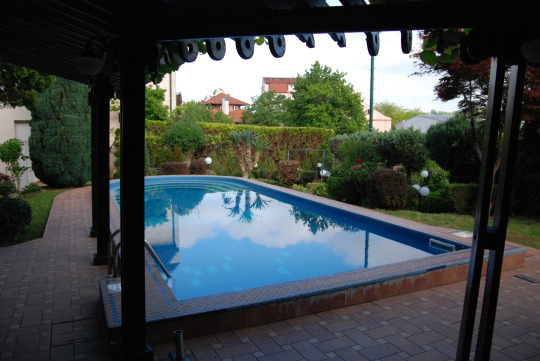

also the view was kinda insane...
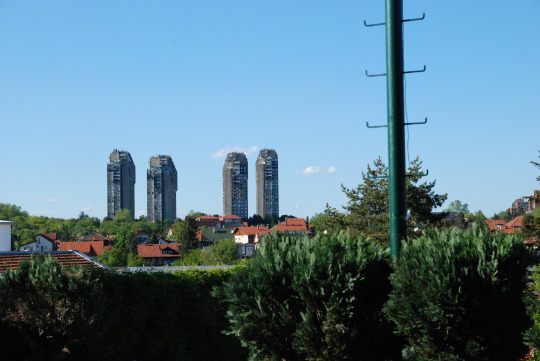
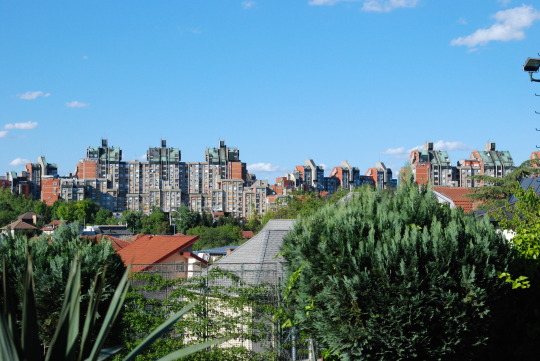
also! here's a pic of a Serbian snail that came out rather nice:
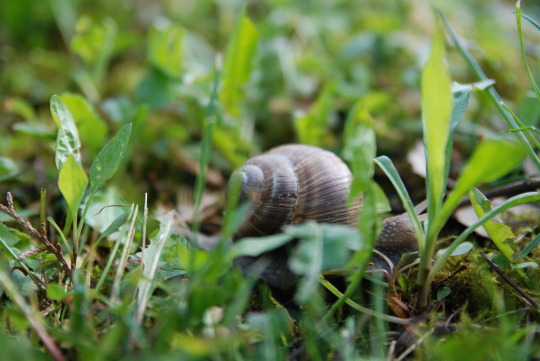
anyway on Saturday we went into the city centre to do some more touristy shit. I went to the two places in Belgrade that presumably everyone goes, namely the Fortress and the Temple. but I also got some shots of the city centre...
(also a tram shot for the trams girls in the audience)
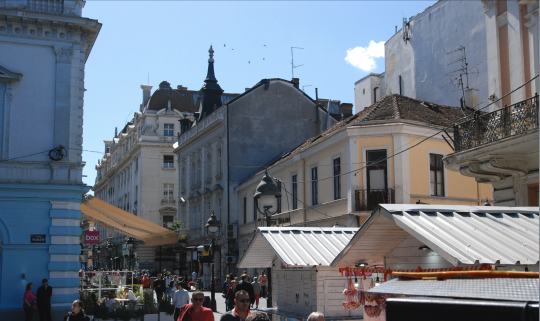
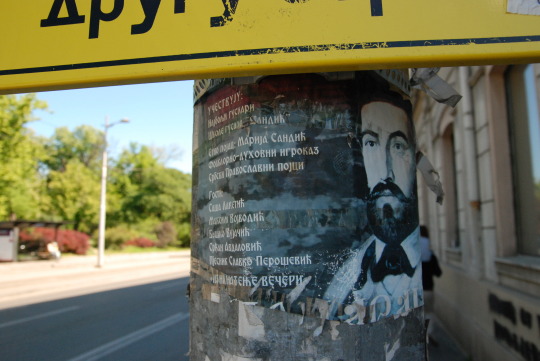
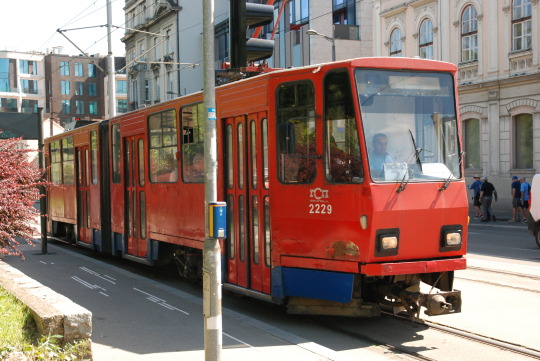
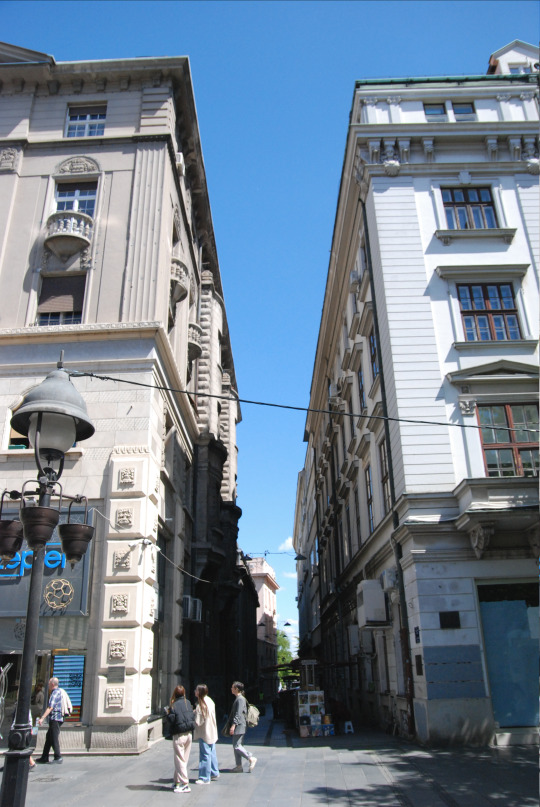

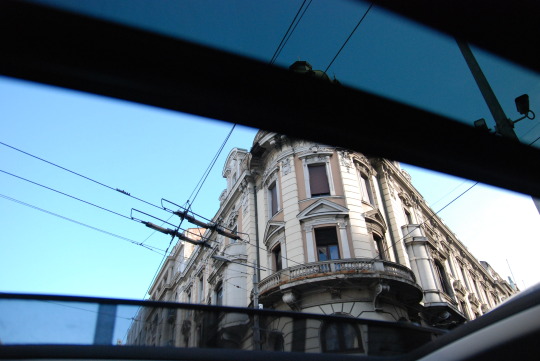
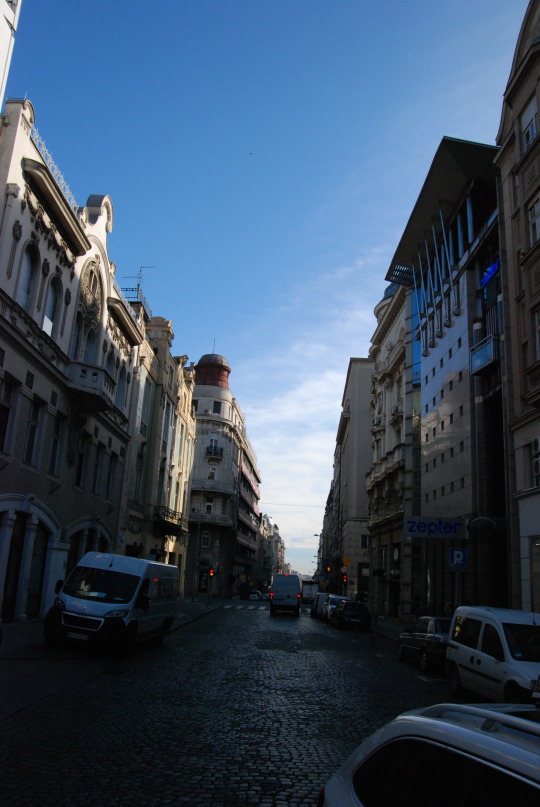
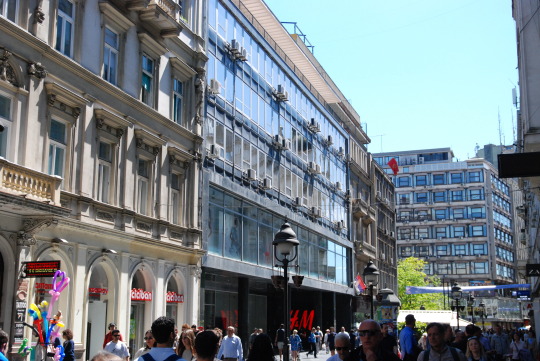
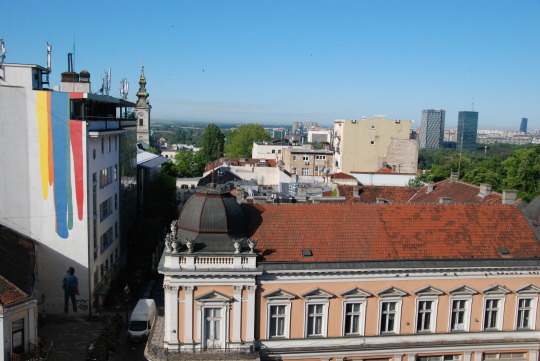
so as you can see, the vibes of central Belgrade are p Southern European sorta architecture, lots of pale stone walls and tiled roofs and the like. but you also have these crazy cool looking tower blocks from the communist period...
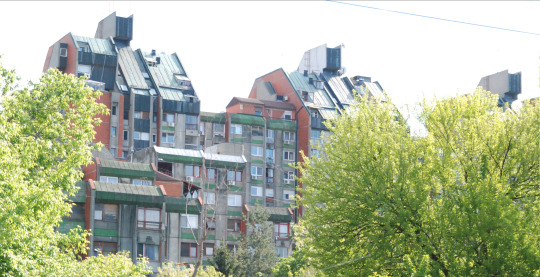
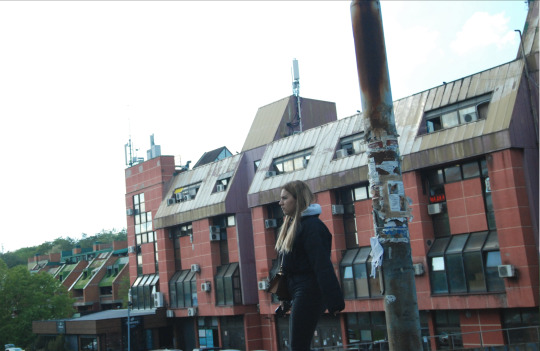
...which were unfortunately quite hard to photograph out of a moving car window.
But yeah, we were on our way to the fortress.
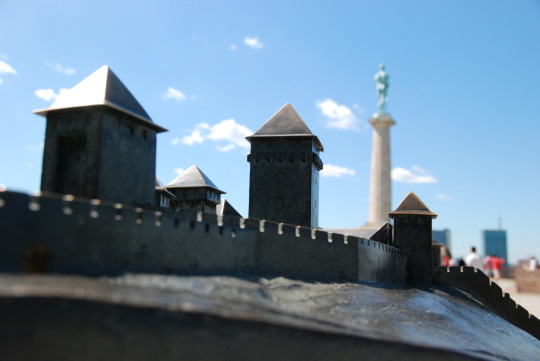
Belgrade Fortress has a pretty storied history. At one point it simply was Belgrade; even after that, it's been occupied by variously the Byzantines, Turks and Austrians, who all made various additions and modifications to the fortress, and sometimes accidentally blew it up. Nowadays it's become a kind of park and tourist area, surrounded by the river, and thus some pretty impressive views...
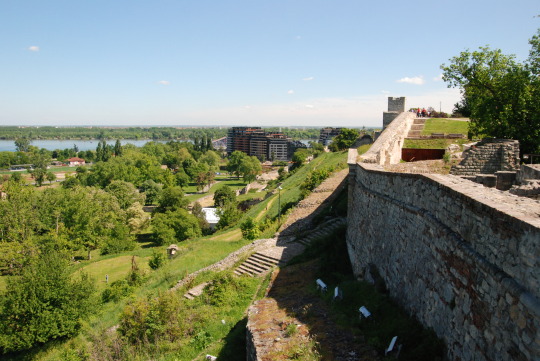

as well as various things that tourists might like to look at, like statues of dinosaurs and tanks, and people dressed Historically.
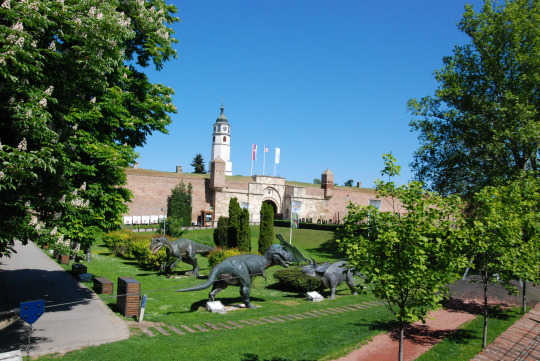
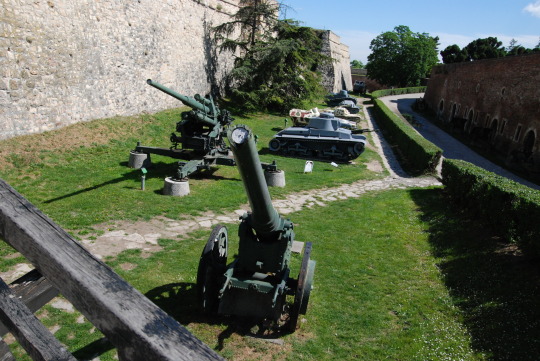
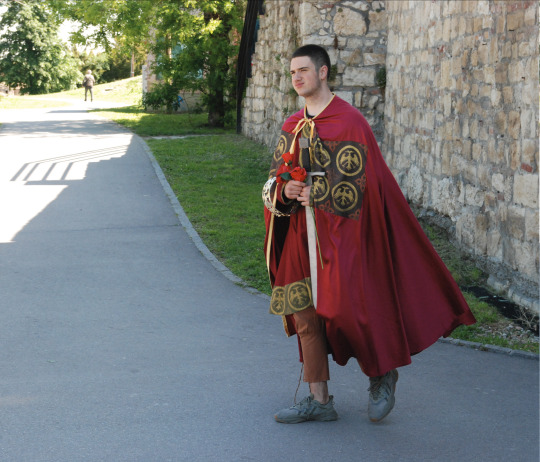
apparently you're only allowed 30 images in a post, so let me make another one for the Temple, which was the craziest building I saw, and the butt statue...
33 notes
·
View notes
Text
Mystic Egyptian Polytheism Resource List
Because I wanted to do a little more digging into the philosophy elements explored in Mahmoud's book, I took the time tonight to pull together the recommended reading he listed toward the end of each chapter. The notes included are his own.
MEP discusses Pharaonic Egypt and Hellenistic Egypt, and thus some of these sources are relevant to Hellenic polytheists (hence me intruding in those tags)!
Note: extremely long text post under this read more.
What Are The Gods And The Myths?
ψ Jeremy Naydler’s Temple of the Cosmos: The Ancient Egyptian Experience of the Sacred is my top text recommendation for further exploration of this topic. It dives deep into how the ancients envisioned the gods and proposes how the various Egyptian cosmologies can be reconciled. ψ Jan Assmann’s Egyptian Solar Religion in the New Kingdom: Re, Amun and the Crisis of Polytheism focuses on New Kingdom theology by analyzing and comparing religious literature. Assmann fleshes out a kind of “monistic polytheism,” as well as a robust culture of personal piety that is reflected most prominently in the religious literature of this period. He shows how New Kingdom religious thought was an antecedent to concepts in Hermeticism and Neoplatonism. ψ Moustafa Gadalla’s Egyptian Divinities: The All Who Are The One provides a modern Egyptian analysis of the gods, including reviews of the most significant deities. Although Gadalla is not an academic, his insights and contributions as a native Egyptian Muslim with sympathies towards the ancient religion are valuable.
How to Think like an Egyptian
ψ Jan Assmann’s The Mind of Egypt: History and Meaning in the Time of the Pharaohs is my top text recommendation for further exploration of this topic. It illuminates Egyptian theology by exploring their ideals, values, mentalities, belief systems, and aspirations from the Old Kingdom period to the Ptolemaic period. ψ Garth Fowden’s The Egyptian Hermes: A Historical Approach to the Late Pagan Mind identifies the Egyptian character of religion and wisdom in late antiquity and provides a cultural and historical context to the Hermetica, a collection of Greco-Egyptian religious texts. ψ Christian Bull’s The Tradition of Hermes Trismegistus: The Egyptian Priestly Figure as a Teacher of Hellenized Wisdom provides a rich assessment of the Egyptian religious landscape at the end of widespread polytheism in Egypt and how it came to interact with and be codified in Greek schools of thought and their writings.
How To Think Like A Neoplatonist
Radek Chlup’s Proclus: An Introduction is my top text recommendation for further exploration of this topic. It addresses the Neoplatonic system of Proclus but gives an excellent overview of Neoplatonism generally. It contains many valuable graphics and charts that help illustrate the main ideas within Neoplatonism. ψ John Opsopaus’ The Secret Texts of Hellenic Polytheism: A Practical Guide to the Restored Pagan Religion of George Gemistos Plethon succinctly addresses several concepts in Neoplatonism from the point of view of Gemistos Plethon, a crypto-polytheist who lived during the final years of the Byzantine Empire. It provides insight into the practical application of Neoplatonism to ritual and religion. ψ Algis Uzdavinys’ Philosophy as a Rite of Rebirth: From Ancient Egypt to Neoplatonism draws connections between theological concepts and practices in Ancient Egypt to those represented in the writings and practices of the Neoplatonists.
What Is “Theurgy,” And How Do You Make A Prayer “Theurgical?”
ψ Jeffrey Kupperman’s Living Theurgy: A Course in Iamblichus’ Philosophy, Theology and Theurgy is my top text recommendation for further exploration of this topic. It is a practical guide on theurgy, complete with straightforward explanations of theurgical concepts and contemplative exercises for practice. ψ Gregory Shaw’s Theurgy and the Soul: The Neoplatonism of Iamblichus demonstrates how Iamblichus used religious ritual as the primary tool of the soul’s ascent towards God. He lays out how Iamblichus proposed using rites to achieve henosis. ψ Algis Uzdavinys’ Philosophy and Theurgy in Late Antiquity explores the various ways theurgy operated in the prime of its widespread usage. He focuses mainly on temple rites and how theurgy helped translate them into personal piety rituals.
What Is “Demiurgy,” And How Do I Do Devotional, “Demiurgical” Acts?
ψ Shannon Grimes’ Becoming Gold: Zosimos of Panopolis and the Alchemical Arts in Roman Egypt is my top text recommendation for further exploration of this topic. It constitutes an in-depth look at Zosimos—an Egyptian Hermetic priest, scribe, metallurgist, and alchemist. It explores alchemy (ancient chemistry and metallurgy) as material rites of the soul’s ascent. She shows how Zosimos believed that partaking in these practical arts produced divine realities and spiritual advancements. ψ Alison M. Robert’s Hathor’s Alchemy: The Ancient Egyptian Roots of the Hermetic Art delves deep temple inscriptions and corresponding religious literature from the Pharaonic period and demonstrates them as premises for alchemy. These texts “alchemize” the “body” of the temple, offering a model for the “alchemizing” of the self. ψ A.J. Arberry’s translation of Farid al-Din Attar’s Muslim Saints and Mystics: Episodes from the Tadhkirat al-Auliya contains a chapter on the Egyptian Sufi saint Dhul-Nun al-Misri (sometimes rendered as Dho‘l-Nun al-Mesri). He is regarded as an alchemist, thaumaturge, and master of Egyptian hieroglyphics. It contains apocryphal stories of his ascetic and mystic life as a way of “living demiurgically.” It is an insightful glimpse into how the Ancient Egyptian arts continued into new religious paradigms long after polytheism was no longer widespread in Egypt.
Further Reading
Contemporary Works Assmann, Jan. 1995. Egyptian Solar Religion in the New Kingdom: Re, Amun and the Crisis of Polytheism. Translated by Anthony Alcock. Kegan Paul International. Assmann, Jan. 2003. The Mind of Egypt: History and Meaning in the Time of the Pharaohs. Harvard University Press. Bull, Christian H. 2019. The Tradition of Hermes Trismegistus: The Egyptian Priestly Figure as a Teacher of Hellenized Wisdom. Brill. Chlup, Radek. 2012. Proclus: An Introduction. Cambridge University Press. Escolano-Poveda, Marina. 2008. The Egyptian Priests of the Graeco-Roman Period. Brill. Fowden, Garth. 1986. The Egyptian Hermes: A Historical Approach to the Late Pagan Mind. Cambridge University Press. Freke, Tim, and Peter Gandy. 2008. The Hermetica: The Lost Wisdom of the Pharaohs. Jeremy P. Tarcher/Penguin. Gadalla, Moustafa. 2001. Egyptian Divinities: The All Who Are The One. Tehuti Research Foundation. Grimes, Shannon. 2019. Becoming Gold: Zosimos of Panopolis and the Alchemical Arts in Roman Egypt. Princeton University Press. Jackson, Howard. 2017. “A New Proposal for the Origin of the Hermetic God Poimandres.” Aries: Journal for the Study of Western Esotericism 17 (2): 193-212. Kupperman, Jeffrey. 2014. Living Theurgy: A Course in Iamblichus’ Philosophy, Theology and Theurgy. Avalonia. Mierzwicki, Tony. 2011. Graeco-Egyptian Magick: Everyday Empowerment. Llewellyn Publications. Naydler, Jeremy. 1996. Temple of the Cosmos: The Ancient Egyptian Experience of the Sacred. Inner Traditions. Opsopaus, J. 2006. The Secret Texts of Hellenic Polytheism: A Practical Guide to the Restored Pagan Religion of George Gemistos Plethon. New York: Llewellyn Publications. Roberts, Alison M. 2019. Hathor’s Alchemy: The Ancient Egyptian Roots of the Hermetic Art. Northgate Publishers. Shaw, Gregory. 1995. Theurgy and the Soul: The Neoplatonism of Iamblichus. 2nd ed. Angelico Press. Snape, Steven. 2014. The Complete Cities of Ancient Egypt. Thames & Hudson. Uzdavinys, Algis. 1995. Philosophy and Theurgy in Late Antiquity. Wheaton, IL: Quest Books. Uzdavinys, Algis. 2008. Philosophy as a Rite of Rebirth: From Ancient Egypt to Neoplatonism. Lindisfarne Books. Wilkinson, Richard H. 2000. The Complete Temples of Ancient Egypt. Thames & Hudson.
Ancient Sources in Translation Attar, Farid al-Din. 1966. Muslim Saints and Mystics: Episodes from the Tadhkirat alAuliya. Translated by A.J. Arberry. London: Routledge & Kegan Paul. Betz, Hans Dieter. 1992. The Greek Magical Papyri in Translation, Including the Demotic Spells. Chicago: University of Chicago Press. Copenhaver, Brian P. 1995. Hermetica: The Greek Corpus Hermeticum and the Latin Asclepius in a New English Translation, with Notes and Introduction. Cambridge: Cambridge University Press. Guthrie, Kenneth. 1988. The Pythagorean Sourcebook and Library: An Anthology of Ancient Writings which Relate to Pythagoras and Pythagorean Philosophy. Grand Rapids, MI: Phanes Press. Iamblichus. 1988. The Theology of Arithmetic. Translated by Robin Waterfield. Grand Rapids, MI: Phanes Press. Iamblichus. 2003. Iamblichus: On the Mysteries. Translated by Clarke, E., Dillon, J. M., & Hershbell, J. P. Atlanta: Society of Biblical Literature. Iamblichus. 2008. The Life of Pythagoras (Abridged). Translated by Thomas Taylor. Whitefish, MT: Kessinger Publishing. Lichtheim, Miriam. 1973-1980. Ancient Egyptian Literature. Volumes I-III. Berkeley: University of California Press. Litwa, M. David. 2018. Hermetica II. Cambridge: Cambridge University Press. Majercik, Ruth. 1989. The Chaldean Oracles: Text, Translation, and Commentary. Leiden: Brill. Plato. 1997. Plato: Complete Works. Edited by John M. Cooper and D. S. Hutchinson. Indianapolis: Hackett Publishing. Plotinus. 1984-1988. The Enneads. Volumes 1-7. Translated by A.H. Armstrong. Cambridge, Massachusetts: Harvard University Press. Van der Horst, Pieter Willem. 1984. The Fragments of Chaeremon, Egyptian Priest and Stoic Philosopher. Leiden: E.J. Brill.
#mystic egyptian polytheism#resource list#philosophy#neoplatonism#egyptian polytheism#hellenic polytheism#hermeticism
59 notes
·
View notes
Text
The last empress
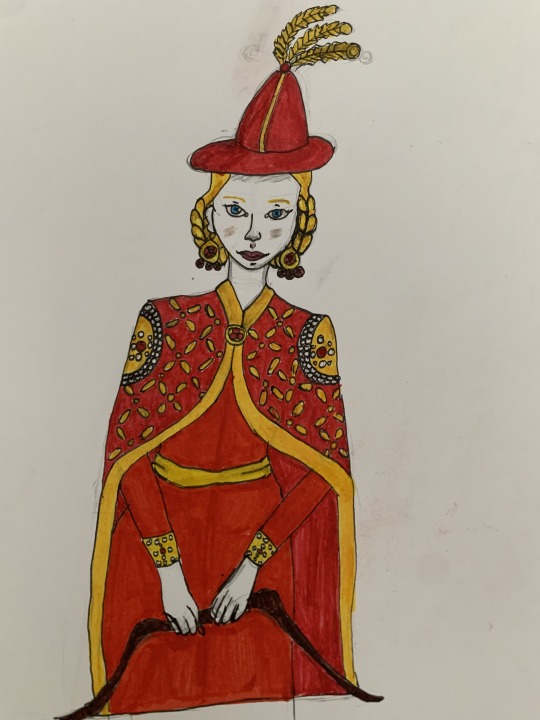
And here is Maria of Trebizond (c.1404-1439) the last crowned Byzantine empress and wife of the penultimate emperorJohn VIII Palaiologos (and one of my favorite empresses).
I based my drawing on Bertrandon de la Broquière's account:
"He then placed the coat over her shoulders and put one of the long, pointed hats of Greece which bears along the said top three golden feathers and which fitted her very well. She seemed to me as beautiful as before. (…) She wore make up, which was unnecessary because she was young and fair-skinned. In each ear she had a hanging earring, large and flat bearing several stones, mostly rubies."
Maria was an active woman who often went hunting with her husband or alone. She rode her horse astride, something that fascinated the foreign visitors. I can't know for sure how she hunted. I chose to give her a bow as an allusion to Pisanello's depiction of her husband. Since her life was marked by many difficult events, I chose to depict her in a happy moment.
Maria was John's third wife, but also the only one that he had personally chosen (his first marriages had been marriages in name only). Her relationship with her husband was by all accounts a happy one, marked by love and respect.
The Ecthesis Chronica tells us that John loved her "beyond measure" because of her beauty and wisdom. He also valued her advice. Due to the Empire's dire situation, John left for Italy in 1438 in the hope of concluding an ecclesiastical union with the Catholic Church and thus obtaining western military aid.
Maria and her mother-in-law Helena Dragaš likely governed the capital in his absence. Maria didn't live to see her husband come back. She became ill, an event reportedly foretold by the appearance of a comet in the sky, and died on December 17, 1439.
John's entourage learned about her death during the return journey. They hid it to the emperor, fearing that his grief would delay their journey further. It was only when John returned to the capital that his mother told him the truth.
The emperor fell into a deep depression and was later buried in Maria's tomb after his death in 1448.
#maria of trebizond#niniane's drawing journey#byzantine empire#women in history#sailing to byzantium#I really wanted to draw her because her story makes me so emotional#this was colored with a lot of patience and love#30+ minutes!#One day I will make a more detailed post about her on my sideblog#In the meantime here it is#John VIII Palaiologos
14 notes
·
View notes
Note
Hello! Hope I'm not bothering you but I found your post about "How Do I Make My Fictional Gypsies Not Racist?" and I wanted to ask you something if it's ok with you. The post cached my attention because you use the term gypsy with easiness and I'm curious about how it's that, because as far as the internet says it's a derogatory term.
It's not the first time I've seen somebody use that word, but the person who used it was Roma, if I remember correctly.
This is absolutely not to accuse you of anything, I just want to know your perspective! Thank you and have a nice day!
Hallo!
Yes, I hoped I'd answered this is my main post but, I'll answer it more explicitly and from more angles here - It'll be in sections because I have a lot of thoughts and they're not in any particular order.
I won't be using asterisks to obscure any words in this post, because precision is important and I don't want to leave any ambiguities about which words I mean, so CN for words for Romani people that are often derogatory, for the rest of the post.
1) Is Gypsy a derogatory word?
Gypsy is an untranslatable word, in that the exact lexical field covered by "Gypsy" isn't matched by any words in other languages. Sometimes, people translate tzigane, gitano, zigeuner, cíkanská etc as "Gypsy" but that's really imprecise and causes more problems - These words aren't all calques or related.
The ones which sound broadly like "sigan" (Cigan, tzigane, zigeuner, cíkanský etc) most likely come via the Balkans and the Ancient Greek word "Athinganoi/Athinganos" - Unambiguously a rude word, untouchable, a caste of itinerant fortune-tellers in the Byzantine Empire, which was applied much in the same way as "Tink/tinker" was applied to Scottish and Irish Travellers - a trade as a synecdoche of a people, and specifically a stigmatised trade at that. And they usually are very much derogatory words (but even then - you will meet Roma living in Romania and Hungary and Czechia etc who do use those words for themselves, and they will have as complicated a relationship with them as we do with Gypsy)
Gypsy... We're less sure. We know it comes from "Egyptians", first applied in Scotland and England to recent Romani migrants in the late 1400s or early 1500s (We see it in the naming of the Egyptians Acts in 1501 and 1531, which refer to both Egyptians and "Counterfeit Egyptians" - Meaning those Romani people, and the local Britons who lived with them, travelled with them and did the same itinerant trades. Presumably, the "Counterfeit Egyptians" of the previous 500 years intermixing with Romani people are why modern Romany (Romanichal, Angloromany, English Travellers, whatever you call us) are so pale compared to southern and eastern European Roma.
But why "Egyptians", we aren't really sure. Top contenders are:
1) The Romani people deliberately passed themselves off as Coptic Egyptians, hoping for welcome as fellow-Christians.
2) Local Britons mistook these brightly-dressed dark-skinned people, speaking an unknown language, for Egyptians.
3) To someone who spoke English, and maybe could recognise French, Dutch, Latin or other especially northern European trading languages, the Romanes language of the time that was closer to Hindi, with Greek and Romanian loanwords, would sound unintelligible - We think that's where we get the English word "Jibberish" and "Jibber" from, from the Romanes word "chib/jib"-"Language". But, potentially, does "Gypsy" come from "Jib-sy", taking the common English slang format of adding "-ies" "-sie" to the end of something to make a name for something from a feature of it (Like "walky-talky" for a portable two way radio, "bluey" to describe a merled dog, "pinky" for a mouse or rabbit before it has fur, "Geordie" and "Cockney" and various other local demonyms) - Potentially we are "The ones that speak the chib" - "the chibsies".
4) It was related to a preexisting racial slur, the idea of "Egyptian" to mean a bizarre, foreign, alien version of something- Hermetics were often called "Egyptian" around the same period, because of their strange rites and beliefs, which were popularly associated with Egypt (As was Hermes Trismagestus).
5) The port area in the Netherlands where they sailed to Scotland from was potentially "Little Egypt" and they were named as such for their port of departure, as migrations are often named for their port of arrival, or departure, or the boat they came on - like talking about Plymouth colonists, Windrush generation, Ellis Island immigrants.
What we do know though, is that the first people that the word Gypsy was applied to, were the ancestors of the modern English-speaking Romany and Kale people of Scotland, England and Wales (ie, my personal ancestors) - Most of whom use "Gypsy" as their preferred word to describe themselves. (Further complications: Other Traveller groups in the UK who also in some contexts will call themselves Gypsies, Water-Gypsies, Irish Gypsies, Gypsy Travellers, who may or may not see themselves as Romani but who often have interlaced family trees and traditions with Romanichal and Kale families.)
Personally, as a Romany Gypsy I usually call myself a Gypsy in English for two reasons:
1) Because in singular, I'd have to choose rom/rawni - not just man/woman but also husband/wife, because our words for adult man/adult woman are the same as the word for husband/wife, and I usually don't want to do that; I'm unmarried, but too old to call myself chavo, and I usually don't want to be explicit about my gender in that way anyway.
2) because the other words for us in English are Romani loanwords. The Romani language is still stigmatised in England, and doubly so Angloromanes, our paralanguage/mixed-language/creole - Children raised speaking it are described as being in "linguistic poverty", we are disciplined at school for "speaking in code" (i still have a speech impediment in Romanes that I don't have in English, after being tortured and humiliated by teachers at school for speaking Romanes. Even getting out a couple of words, I stutter and fail, from shame) - and the police and courts describe our language as "thieves' cant" and further punish us for speaking it, they still treat people speaking it as evidence of planning crimes, a final vestige of those Egyptians Acts which levied the death sentence on anyone speaking Romany.
So when a gorjer prefers that I call myself Rromani rather than Gypsy, I hear that as a demand to perform my language for them, for their titillation and for their comfort, so that they can try to forget that for hundreds of years we have been executed, imprisoned, transported, beaten, and treated as second class citizens, for speaking our language. So, no, gorjers don't get to hear one single beautiful word of our language, they can hear "Gypsy" and their ears can burn with the shame of what they still do to us.
So is Gypsy a word that gorjers should use?
Context matters.
Are you talking about an organisation like the Gypsy Lore Society, or a modern Gypsy And Traveller Exchange, or things made by us like Gypsy Pegs, Gypsy Flowers, Gypsy Bangles, Gypsy Jazz? Go for it, use the capital G, in the same way as you capitalise French food, German engineering, Ukrainian poetry. If an organisation describes itself as being for Roma, don't assume that you can translate that to 'for Gypsies', but likewise you can't assume that 'for Gypsies' can be translated to 'for Roma' - All Roma are Romani, not all Romani are Roma (As in, they might be Sinti, Manouche, Roma, Romanisael, Kale, Romany... etc).
Do you want to describe something made by gorjers as Gypsy-like, or describe a gorjer as being like a Gypsy... Then don't.
There is probably a second post to write about this, on the theory of "Gypsy-ing", how the archetype of the Gypsy is created and applied to populations in different ways, but this is already very long and very tiring so, thank you for bearing with me this far!
13 notes
·
View notes
Text
Coptic Women's Headpieces: padded headbands and Palmyran strips
Neither of these have much (...in the first case, any) information out there to make their own post about, but they're both interesting.

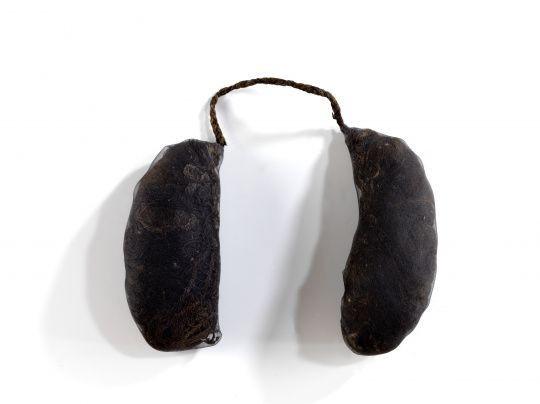
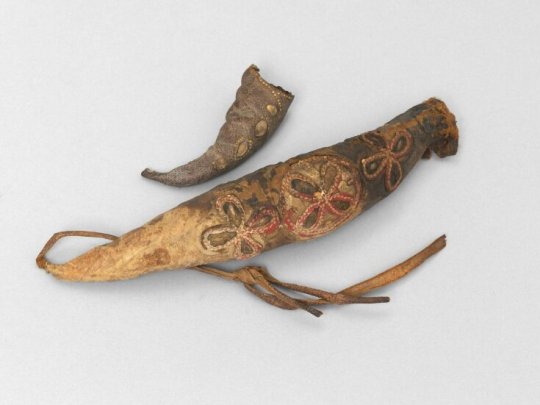
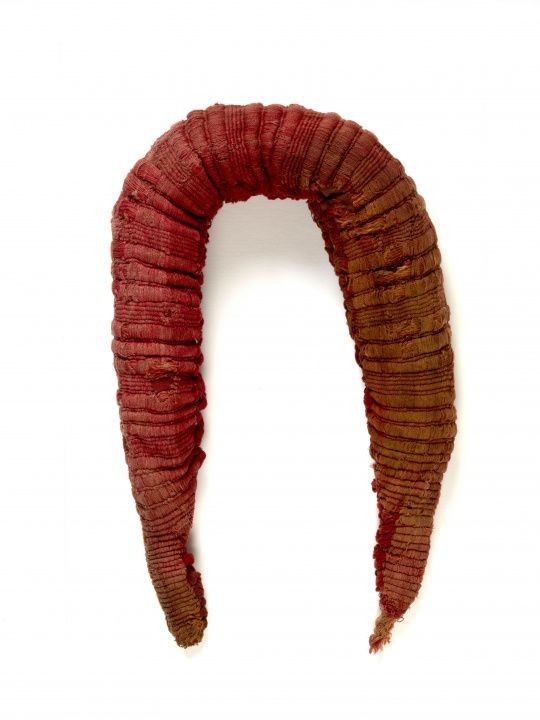
The first are these padded headpieces. In the past I'd only seen the one made of leather with flowers on it in the V&A, which notes its possible usage. However it was only until recently when I began poking around on the French internet when I found more, and better yet, an undeniable depiction of a woman wearing the headpiece. Before this I'd seen some depictions that may be the headpiece being worn, but usually seem much flatter than these were made to be or like they're a more standard gold diadem.
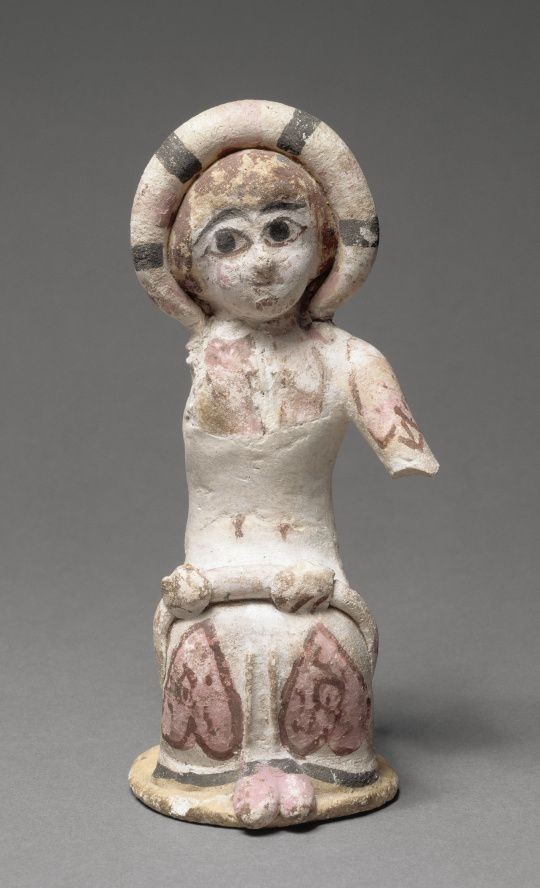
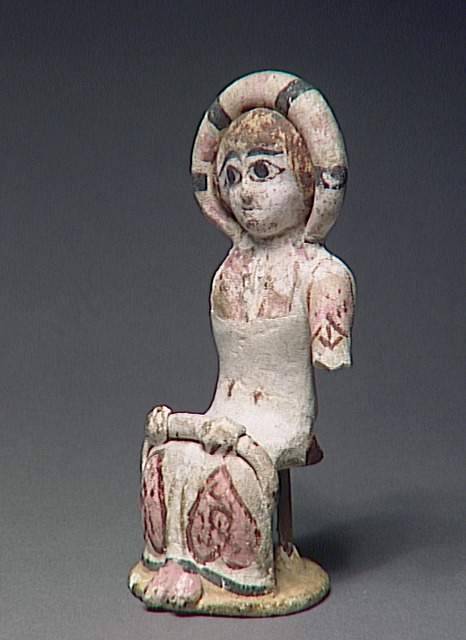
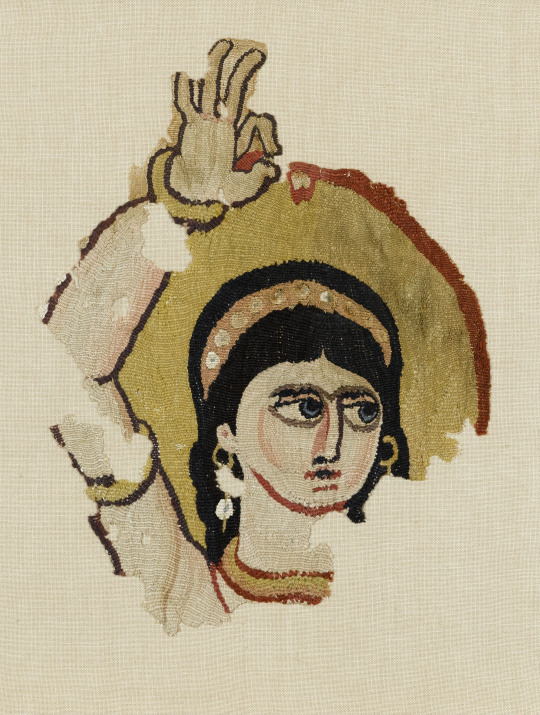
In addition to this, there are a few depictions of Coptic figures wearing these flower bud/petal crowns (more popular in the earlier part of Roman Egyptian art history), which makes me wonder if these were ever used as a base for those.
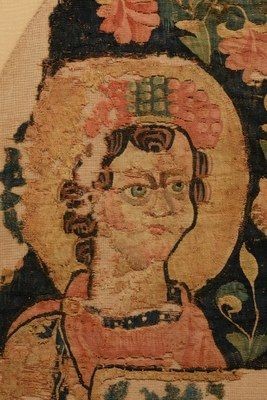
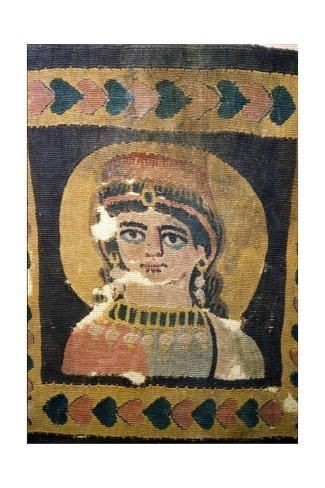
It's also possible this was out under the turbans worn by women in Coptic art. An example of a bust from Byzantine exists of a woman wearing a turban from Constantinople, and when viewed from the side it can be seen that the volume at the front of her headdress terminates in points near the nape of her neck/her ears. However, this bust also lacks the volume one would expect from the examples if a roll like the extant examples was used.

The other piece is one I noticed before, and isn't specific to Egypt, or originated from there. It seems to have come from Palmyra, and is fairly common in the funeral busts we have from there.
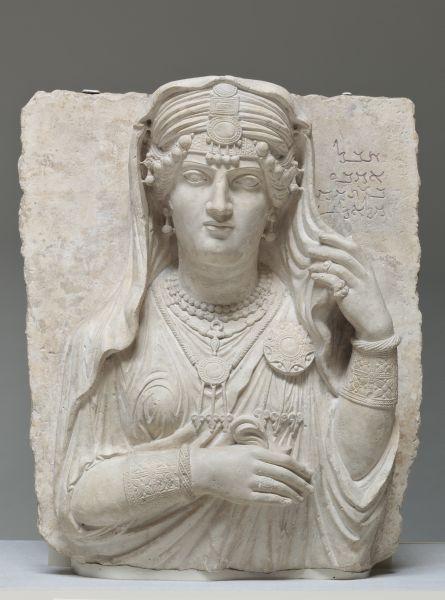
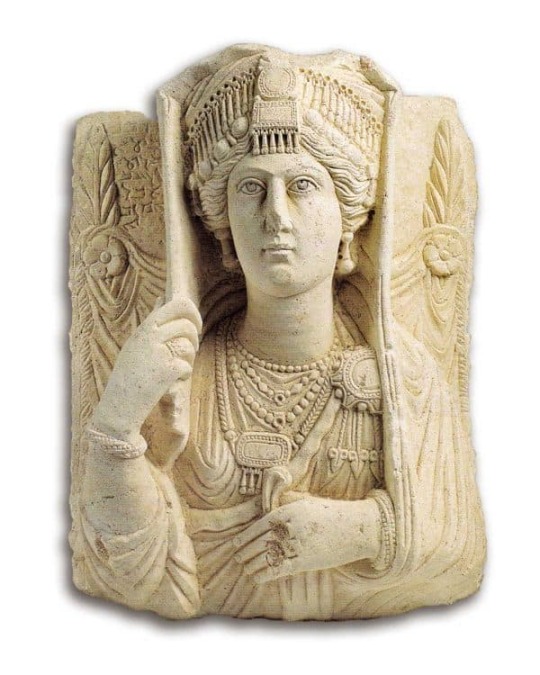
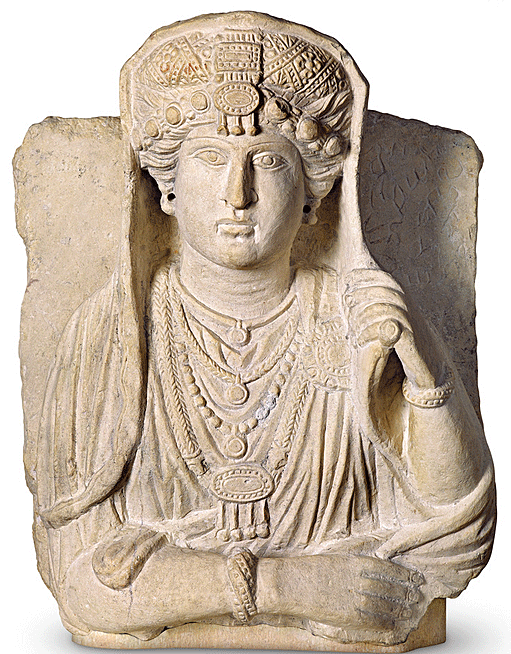
These are small plaques of metal and gems, typically with a few small beads dangling over the forehead. Currently it's supposed that they were attached to a woman's bun in some way.
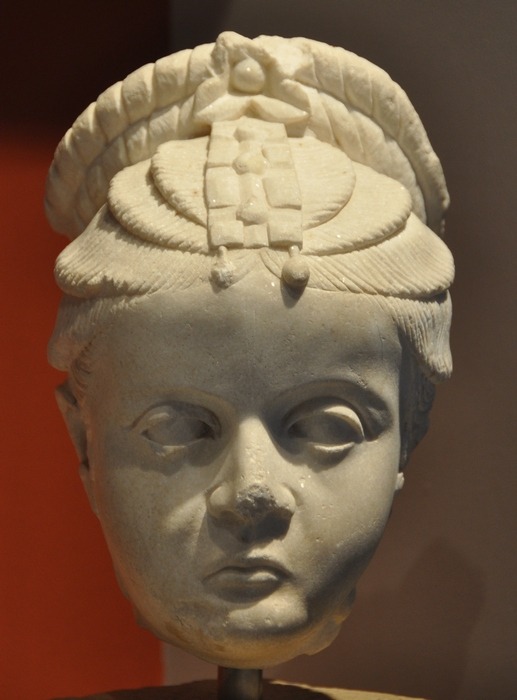
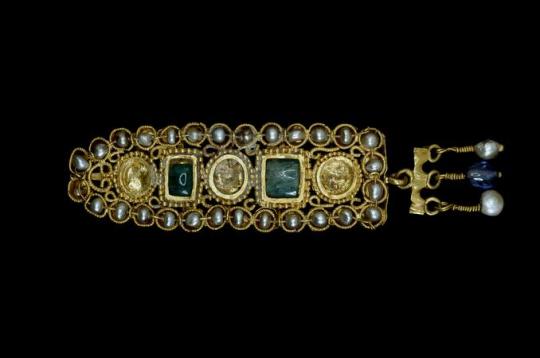
Here's a Roman-era Greek bust and a Roman- era Tunisian example.
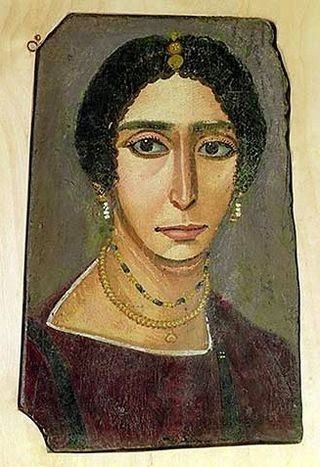
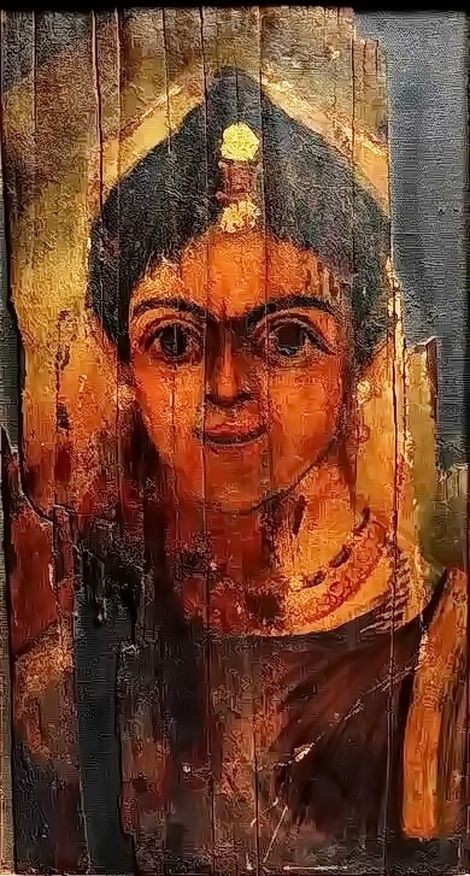
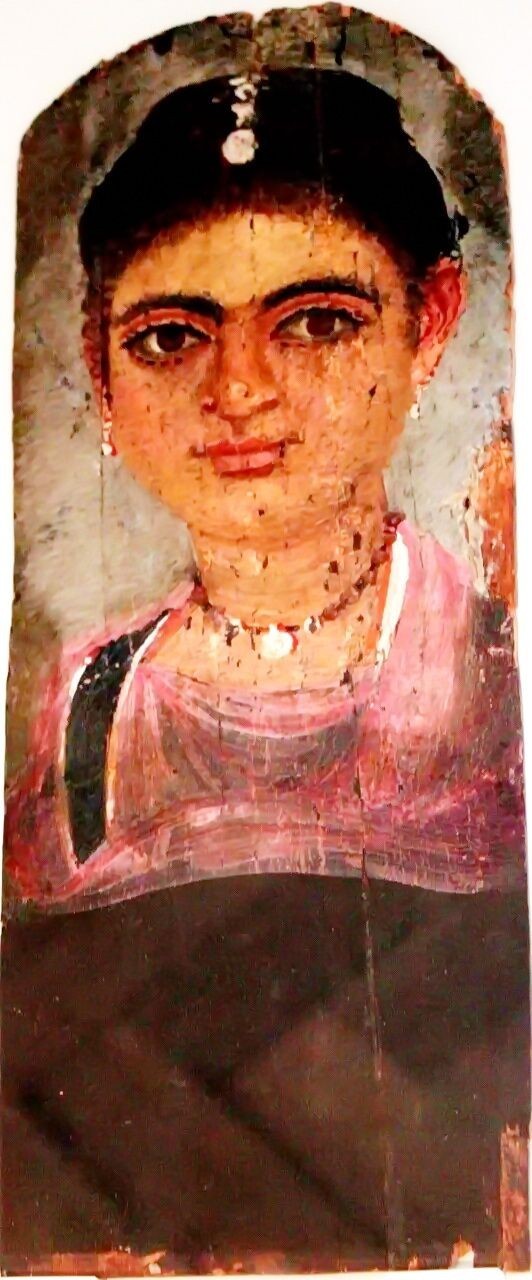
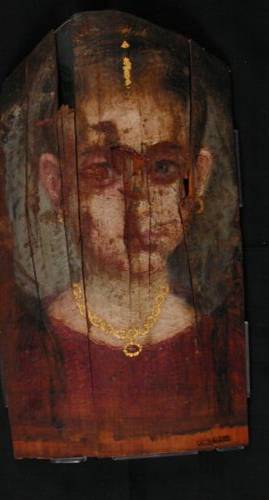
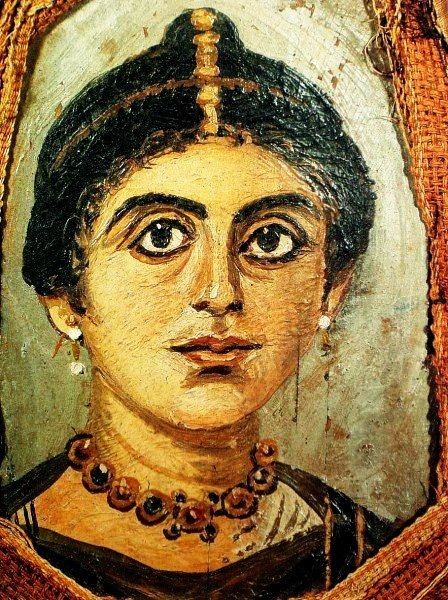
Heres some Roman-Egyptian portraits with similar head jewelry. So far, I haven't found a definitive later Coptic depiction of one being worn, but I don't think that means they stopped being worn before Christianization. It's possibly just a matter of what art has survived and what I've personally seen. Generally, Coptic jewelry is similar to the jewelry from earlier Roman-Egyptian examples, with some more unique examples and examples that were inspired by later trends in the Byzantine Empire.
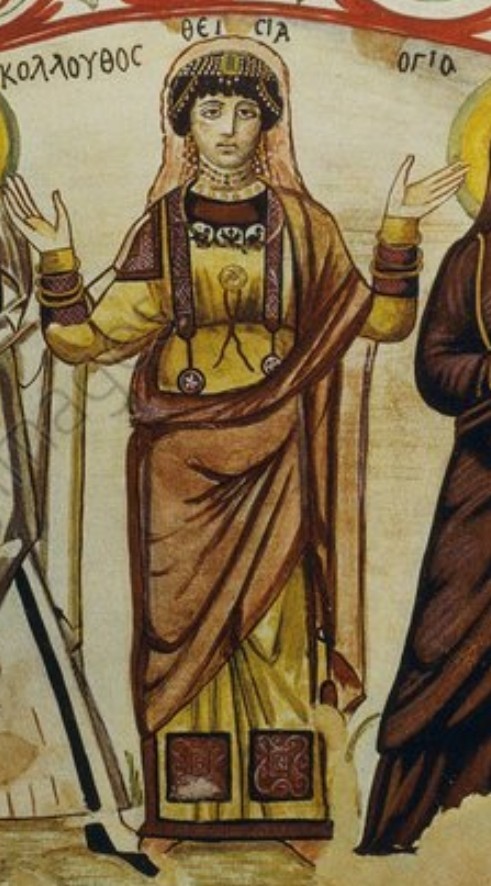
One of the possible Coptic examples is from the tomb of Theodosea (full disclosure: Theodosea herself was Greek Christian living Egypt, not a Copt in the sense we mean it now, but she's dressed in a way generally common in Egypt at the time. I use "possible Coptic example" here to indicate the contemporary cultural majority of Egypt, which is distinct from the pre-Christian cultural identity of native Egyptians). Theodosea here is identified by Engy Hanna as wearing some type of golden hairnet, with a green pendant with 3 hanging pearls and two strings of hanging beads attached. Because of her palla, it's impossible to tell if she has only one medallion attached to her hairnet or if this is a strip. The overall composition of elements (a cover over the hair, the two strands, center ornament, and a shawl over top the head) are very similar to Palmyran headdresses, though she doesn't wear a turban or the patterned fillet they do.
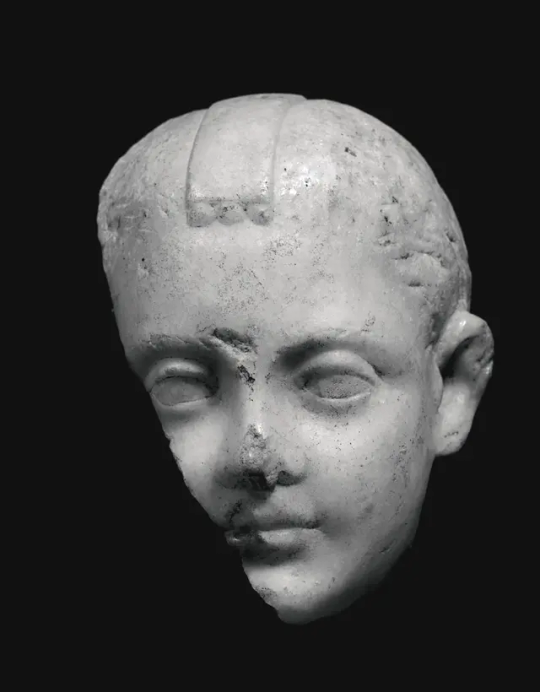
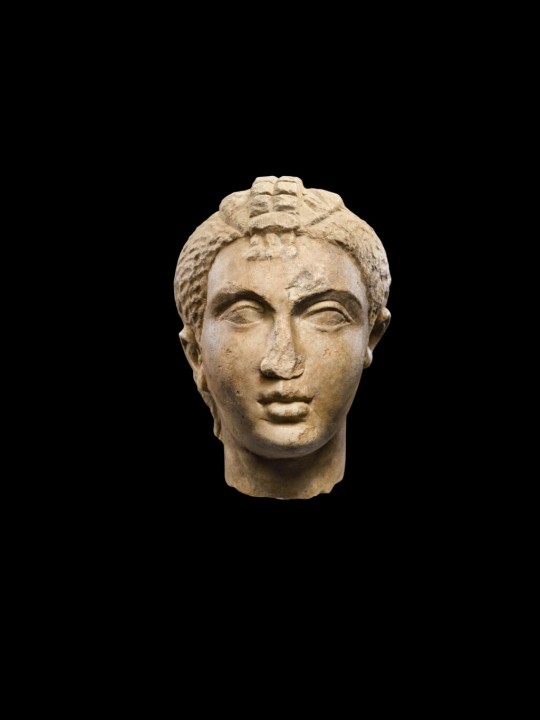
Recently, I found a bust on an auction site labeled "Roman, probably made in Egypt" from the 1st century, with this ornament but made of a more pliable material- probably fabric. And another on the same site, maybe Egyptian (the information mentions both the terms Gandhara and Greco-Egyptian), with the more typical jeweled look, 2nd-3rd century (which is more into the swing of Christianization in Egypt).

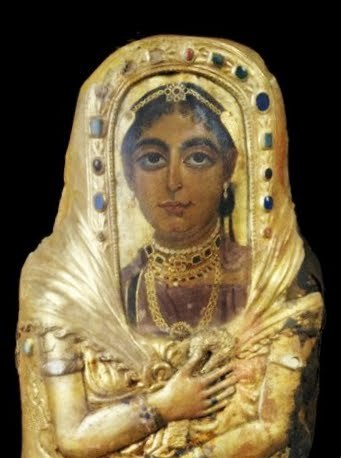
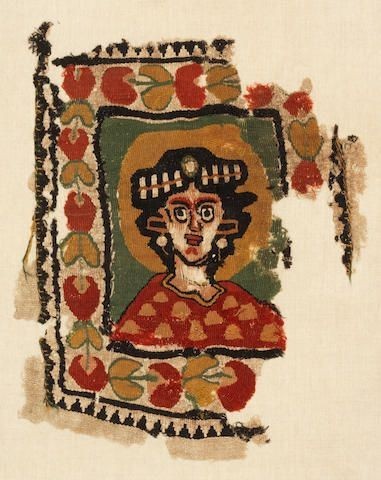

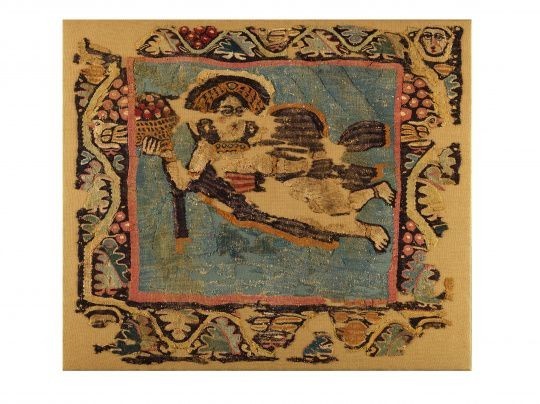
The last aside is another jewelry piece resembling that of Palmyra, though less so: a kind of circlet that appears to be made of chain with a center pendant. The star pendant worn by the second woman also notably resembles the pin holding the strip to the Greek girl's updo. The hanging strands of Theodosea are more blatant, but it's possible these were elaboration on the fashion. This style of jeweled forehead circlet, unlike the headband and strip (I have seen art of Syrian and Egyptian women with a strip, as well as Nubian art of women with a fillet/circlet and a center strip. The latter seems to be a more widely used item than the former two, which I have only seen one depiction each of so far), has remained consistently popular in West Asia and North Africa. Additionally the padded band worn by one of the Palmyran women featured here could be a related item to the padded headband; to know one would have to see the back of her head or find an artifact connecting the two. Even if a relationship can be proven between the Byzantine, Palmyran, and Coptic padded fillets, there is no clear indication of where it originated.
*I am a Copt, and if you are not, do not tag this post talking about "recreations". I find that offensive given the actions taken by Albert Gayet in regard to the clothes he took from graves. It is a simple boundary and you will not "enlighten" me to see how it's fine.*
Sources/Further reading:
https://art.rmngp.fr/fr/library/artworks/femme-assise_terre-cuite_polychromie-technique
https://art.rmngp.fr/fr/library/artworks/bourrelet-de-coiffure-postiches_laine-textile
https://art.rmngp.fr/fr/library/artworks/bourrelet-de-manteau_laine-textile
https://art.rmngp.fr/fr/library/artworks/bourrelet-de-mantelet_laine-textile_textile-matiere_lin-fibre | sources for 3 of the padded fillets and the figurine
https://collections.vam.ac.uk/item/O353014/pair-of-fillets-unknown/
https://www.metmuseum.org/art/collection/search/468716 | the marble bust
https://www.persee.fr/doc/bch_0007-4217_1969_num_93_2_4903 | in German, has photos of carvings with the hair ornament
https://www.sothebys.com/en/auctions/ecatalogue/2016/ancient-marbles-classical-sculpture-art-l16260/lot.59.html | carving of the short haired child
https://www.sothebys.com/en/buy/auction/2022/ancient-sculpture-and-works-of-art/a-roman-marble-portrait-head-of-a-girl-circa-2nd | carving of a girl with a jeweled strip, may be Egypt as the notes say an image of it was published in a work on Greco-Egyptian art and the girl has an "Isis lock" hairstyle
https://www.jstor.org/stable/4241695 | overview of Palmyran jewelry
https://www.britishmuseum.org/collection/object/G_1903-0717-3 | Tunisian example of strip
https://www.livius.org/pictures/greece/thessaloniki/thessaloniki-museum-pieces/thessaloniki-portrait-of-a-girl/
https://womenofegyptmag.com/2020/02/11/what-coptic-artefacts-tell-us-about-women-in-ancient-egypt-part-one/
#Coptic art#Coptic culture#Late Antiquity#Late Antique Egypt#Masr#Copt#Actually Egyptian tag#Cipher talk
109 notes
·
View notes
Text
Discovering the world
Lebanon 🇱🇧
Basic facts
Official name: الجمهورية اللبنانية (al-Jumhūrīyah al-Lubnānīyah) (Republic of Lebanon)
Capital city: Beirut
Population: 5.3 million (2023)
Demonym: Lebanese
Type of government: unitary parliamentary republic
Head of state: vacant (President)
Head of government: Najib Mikati (Prime Minister)
Gross domestic product (purchasing power parity): $78.23 billion (2022)
Gini coefficient of wealth inequality: 31.8% (medium) (2011)
Human Development Index: 0.723 (high) (2022)
Currency: pound (LBP)
Fun fact: It hosts the highest number of refugees per capita and per square kilometer.
Etymology
The country’s name comes from Mount Lebanon, whose name derives from the Phoenician root lbn, meaning “white”.
Geography
Lebanon is located in West Asia and borders Syria to the north and east, Israel to the south, and the Mediterranean Sea to the west.
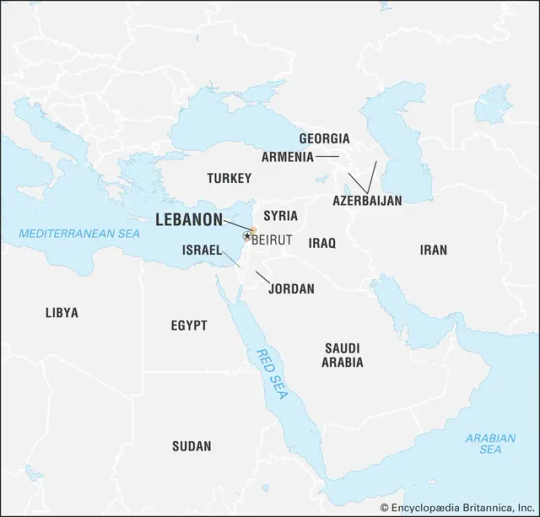
There are two main climates: Mediterranean-influenced humid continental in the center and east and hot-summer Mediterranean in the rest. Temperatures range from 11 °C (51.8 °F) in winter to 30 °C (86 °F) in summer. The average annual temperature is 20.9 °C (69.6 °F).
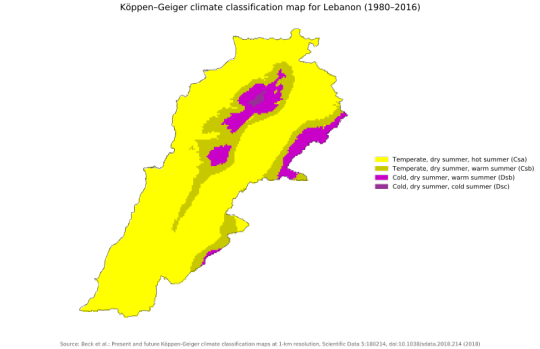
The country is divided into nine governorates (muḥāfaẓāt), which are further divided into twenty-five districts (aqdyah). The largest cities in Lebanon are Beirut, Tripoli, Jounieh, Zahlé, and Sidon.
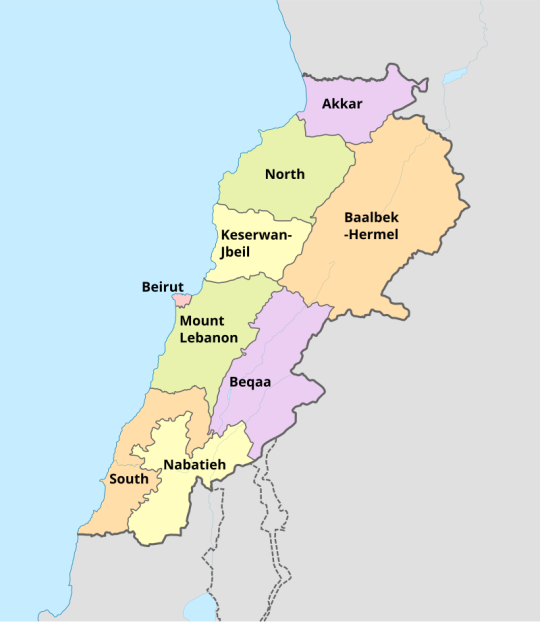
History
2500-64 BCE: Phoenicia
1650-1180 BCE: Hittite Empire
1550-1069 BCE: New Kingdom of Egypt
550-332 BCE: Achaemenid Empire
332-64 BCE: Seleucid Empire
64 BCE-394 CE: Roman Empire
394-635: Byzantine Empire
619-629 CE: Sasanian Empire
636-661: Rashidun Caliphate
661-750: Umayyad Caliphate
750-1517: Abbasid Caliphate
1099-1291: Kingdom of Jerusalem
1102-1289: County of Tripoli
1250-1516: Mamluk Sultanate
1516-1842: Emirate of Mount Lebanon
1516-1918: Ottoman Empire
1843-1861: Double Qaim-Maqamate of Mount Lebanon
1860: civil conflict in Mount Lebanon and Damascus
1915-1918: Great Famine of Mount Lebanon
1920-1926: State of Greater Lebanon
1923-1946: Mandate for Syria and the Lebanon
1926-1943: Lebanese Republic
1943-present: Republic of Lebanon
1948: Arab-Israeli War
1975-1990: Lebanese Civil War
1976-2005: Syrian occupation
1985-2000: South Lebanon conflict
2005: Cedar Revolution
2006: Lebanon War
2006-2008: protests
2007: Lebanon conflict
2011: Intifada of Dignity
2019: 17 October Revolution
2020: Beirut explosion
2021: Beirut clashes
Economy
Lebanon mainly imports from the European Union, Türkiye, and China and exports to the European Union, the United Arab Emirates, and Switzerland. Its top exports are diamonds, polyacetals, and gold.
It has natural gas, limestone, oil, and salt reserves. Services represent 83% of the GDP, followed by industry (13.1%) and agriculture (3.9%).
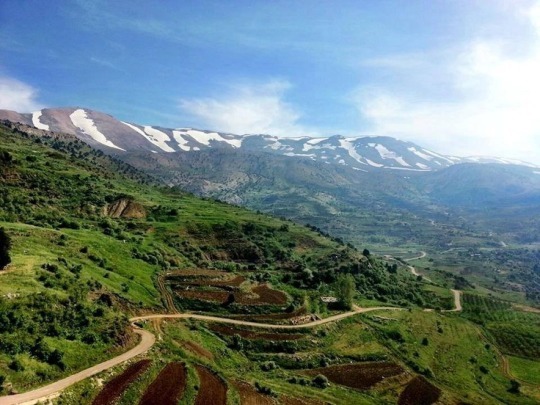
Lebanon is a member of the Arab League, la Francophonie, and the Organization of Islamic Cooperation.
Demographics
95% of the population is Arab, while Armenians make up 4%. The main religion is Islam, practiced by 55% of the population, 27.6% of which is Sunni.
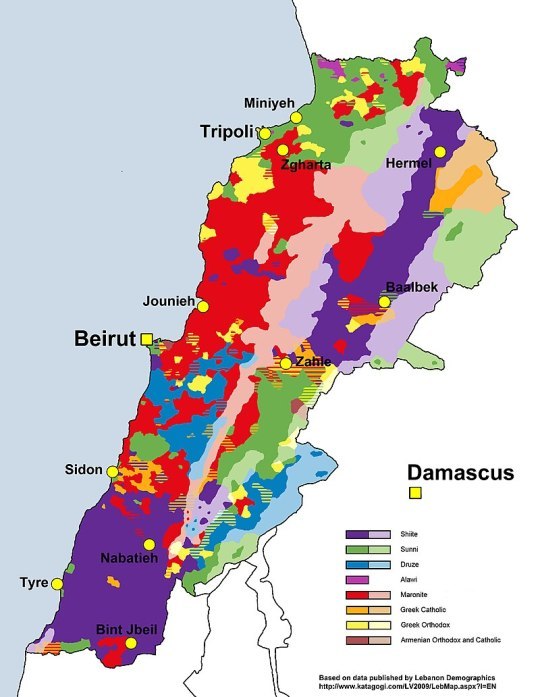
It has a negative net migration rate and a fertility rate of 1.7 children per woman. 89% of the population lives in urban areas. Life expectancy is 78.3 years and the median age is 31.3 years. The literacy rate is 96.7%.
Languages
The official language of the country is Arabic. French is spoken by 40% of the population.

Culture
Lebanese culture has Persian, Greek, Roman, Arab, Ottoman, and French influences. Lebanese people are very gregarious.
Men traditionally wear a shirt, a dark vest, baggy pants (sherwal), a belt, and a headdress. Women wear a shiny dress (gambaz), a wide belt, and a conical hat with a long piece of silk (tantur).
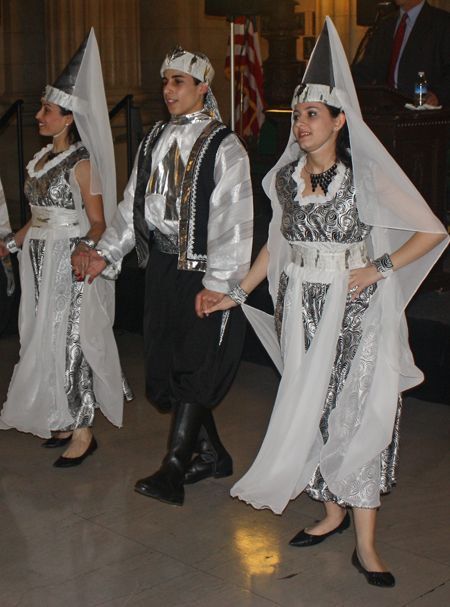
Architecture
Traditional houses in Lebanon are made of stone and wood and have flat roofs and terraces.
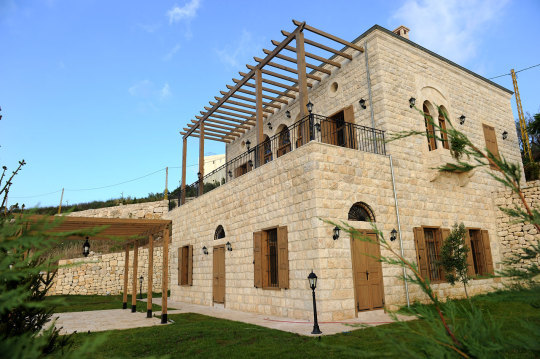
Cuisine
The Lebanese diet is based on fish, meat, pulses, and vegetables. Typical dishes include bamieh bi-zeit (okra and tomato stew), kibbeh (fried balls made of spiced meat and bulgur), sayadieh (seasoned fish and rice), sfouf (an almond-semolina cake), and tabbouleh (a salad of bulgur, onion, tomatoes, and parsley).
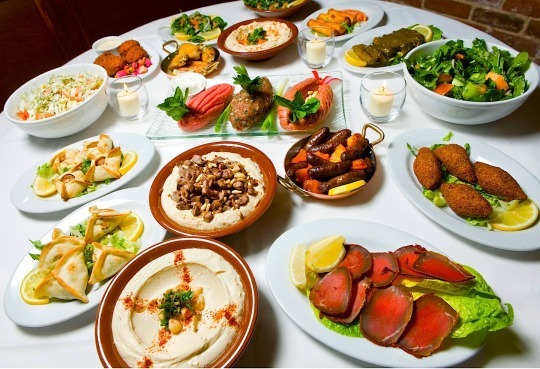
Holidays and festivals
Like other Christian and Muslim countries, Lebanon celebrates Epiphany, Armenian Christmas, St. Maroun Day, Feast of the Annunciation Day, Good Friday, Easter Sunday, Assumption, Christmas Day, Islamic New Year, Ashura, Mawlid, Eid al-Fitr, and Eid al-Adha. It also commemorates New Year’s Day and Labor Day.
Specific Lebanese holidays include Rafic Hariri Memorial Day on February 14, Liberation and Resistance Day on May 25, and Lebanese Independence Day on November 22.
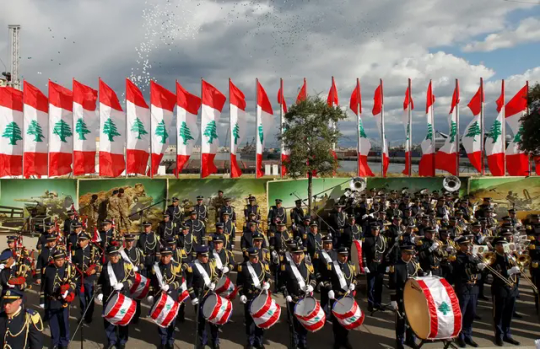
Independence Day
Other celebrations include the Aerial and Circus Arts Festival, the Baalbeck International Festival, which features dance and music performances, and the Beiteddine Art Festival.

Baalbeck International Festival
Landmarks
There are six UNESCO World Heritage Sites: Anjar, Baalbek, Byblos, Ouadi Qadish (the Holy Valley) and the Forest of the Cedars of God (Horsh Arz el-Rab), Rachid Karami International Fair-Tripoli, and Tyre.
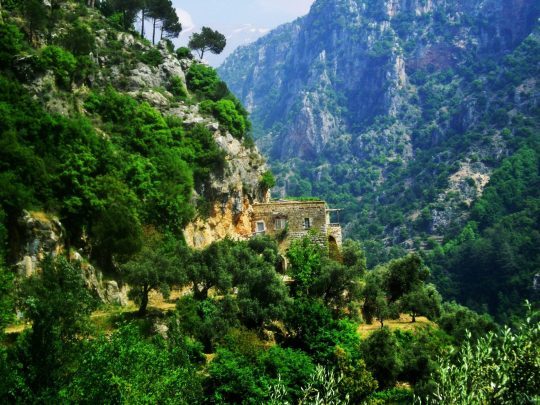
Ouadi Qadish and the Forest of the Cedars of God
Other landmarks include Jabal Moussa, the Mohammad Al-Amin Mosque, the Moussa Castle, Our Lady of Lebanon, and the Tripoli Citadel.
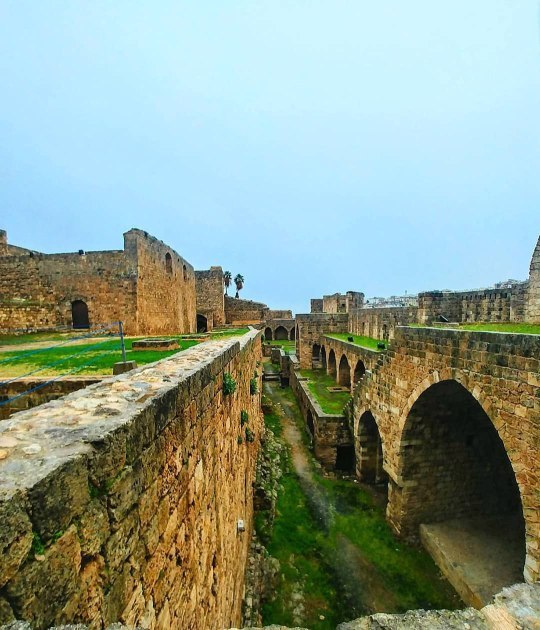
Tripoli Citadel
Famous people
Amin Maalouf - writer
Elie Saab - fashion designer
Fares Fares - actor
Jackie Chamoun - skier
Khalil Beschir - racing driver
May Ziade - poet and writer
Nadine Labaki - actress
Najwa Karam - singer
Ragheb Alama - singer
Rima Fakih - model

Rima Fakih
You can find out more about life in Lebanon in this post and this video.
7 notes
·
View notes
Photo
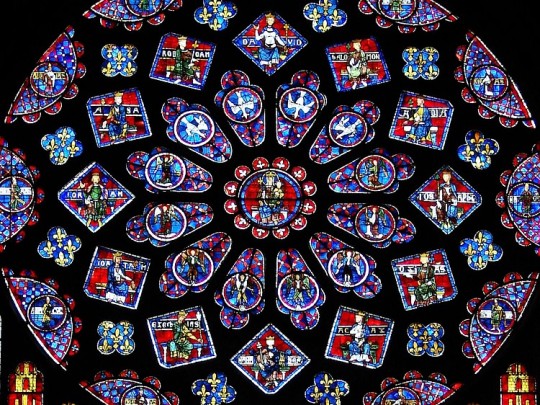
The Stained Glass Windows of Chartres Cathedral
The 167 stained glass windows of Chartres Cathedral, built 1190-1220 CE, are the most complete group surviving anywhere from the Middle Ages. Several windows date to the mid-12th century CE while over 150 survive from the early 13th century CE. There are religious scenes to tell the faithful the key stories of the Bible as well as countless depictions of saints, kings, queens, nobles, knights, and priests. The city's merchants donated 42 windows to the cathedral, and they crop up in many smaller scenes showing the full range of medieval professions from barrel-makers to butchers.
Medieval Stained Glass
The technique of staining glass for windows using metal oxides dates back to at least the 7th century CE and the churches of the Byzantine Empire. However, the craft really became a refined art in the 12th and 13th centuries CE. The five main colours used to 'stain' glass were bright ruby red, which came from copper oxide, sapphire blue from cobalt oxide, green from iron oxide, yellow from sulphur or soot, and purple from manganese oxide. These materials were added to the glass while it was being heated, but because the result proved too opaque to allow much light through, often a thin layer of coloured glass was laid on top of a thicker pane of transparent or white glass. Painted on the interior side of the glass, details of scenes were rendered using a mixture of glass fillings, metal oxides, and vinegar or urine. The paint was then permanently fused onto the glass by putting the pieces into a kiln.
Individual pieces of stained and painted glass were specially cut according to a design chalked out beforehand on a wooden board and then inserted into lead borders to make a single composite panel. The finished panel was then mounted into the metal armature of the window frame using dowels and metal strips. A single tall lancet window at Chartres may include over 50 such panels of all shapes and sizes.
Not only decorative, the windows were also intended as a pictorial guide to the Gospel message in an era when few could read. Consequently, the wages of sin, the benefits of salvation, and the lives of the most important saints and biblical figures are shown as a lesson to all. Most windows, when they tell a narrative such as the life of an apostle or Bible parable, should be read from left to right starting at the base. Four-leafed rosette or quatrefoil panels are read by looking first at the bottom leaf, then the left, centre, and right leaf, and finally the top leaf. Following are descriptions of only some of the most important and striking windows in Chartres cathedral.
Continue reading...
65 notes
·
View notes
Text
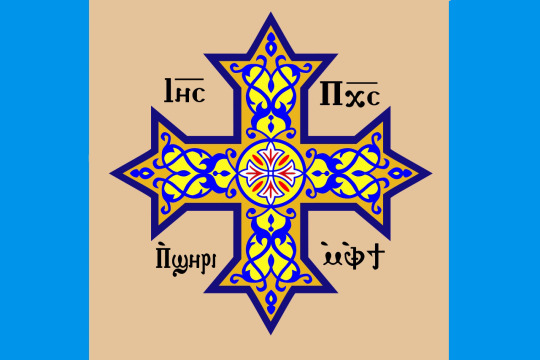
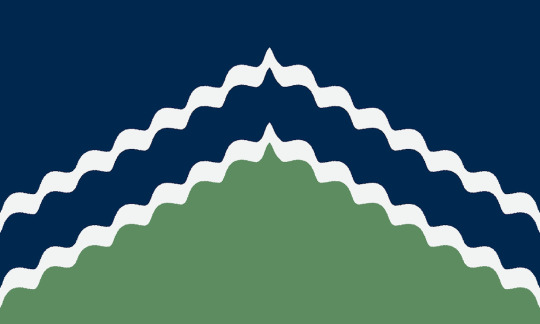
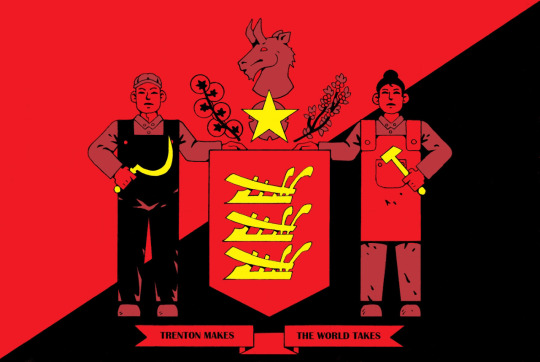
People’s Flag Wars: Round 1, Bracket 11
See the symbolism below.
Coptic Egypt is a flag by @arthurdrakoni.
Symbolism: “This is the flag of Coptic Egypt. It comes from a world where Islam was never founded. One of the many consequences of this was that the Byzantine Empire continued to prosper for a number of years. Eventually, however, tensions began to grow within the empire. Egypt began to feel that Constantinople was giving them the short end of the stick a bit too often. Egypt's main grievances were increased taxes and increased tensions between the Coptic and Orthodox churches. After a brief war, Egypt was granted its independence. Despite this, Egypt retains good relations with Byzantium. It also maintains good relations with fellow Oriental Orthodox nations Ethiopia and Armenia. Egypt has traditionally been a hub of trade, and following its independence work began on a canal in the Sinai Peninsula. Egypt established traditions ports in India and China. It also established colonies in Australia, which is known as New Egypt, as well as a few minor colonies in South America.
The wealth from its trade and colonies has made Egypt a very rich nation. People and goods from throughout the world can be found across Egypt's cities. Currently there is something of an architectural fad based around reinterpretations of Ancient Egyptian architecture. Egypt also has a reputation for having some of the best universities and centers of learning in the world. It is a nation which honors its past while keeping an eye towards the future.
The flag contains a Coptic Cross to represent Egypt's Coptic faith. The background represents the sands of Egypt, while the blue bands stands for the waters of the Nile River. The writing is in the Coptic Script and reads "Jesus Christ, Son of God".”
Forest City Flag is a flag by @forestcityflag.
Symbolism: “The Forest City is a new flag for Cleveland, highlighting both our history and environment. The blue top half represents Lake Erie, our very own inland sea. The green bottom half represents the Forest City nickname and the Emerald Necklace of our Metroparks. The wavy chevron in the center represents the Cuyahoga River winding its way through downtown. The pattern is inspired by a design from Moses Cleaveland's coat of arms (he's the guy who invented Cleveland). At the same time, the upward facing arrow is reminiscent of the city's motto "Progress and Prosperity," pointing up towards the future.”
New Jersey Autonomous Zone is a flag by @lil-tachyon.
Symbolism: “The design is based on the original New Jersey flag but re-imagined in the context of some kind of anarcho-communist future. The buff field of the NJ flag is replaced by the bisected black/red used by anarcho-communists and syndicalists. The coat of arms has the godesses Liberty and Ceres replaced by workers wielding a sickle and hammer, the horse head replaced by the head of the Jersey Devil, a yellow Star backed by a slice of pork roll replacing the helmet, and tomatoes and cranberries flanking the star. The motto is changed from "Liberty and Prosperity" to "Trenton Makes, The World Takes," the words infamously featured on the Lower Trenton Bridge.”
20 notes
·
View notes
Text

Queen Drichglur is thrilled that King Goffredo is showing her love and appreciation by taking the effort to learn her native language - Sardinian Vulgar. Given how Lustful King Goffredo is, they both spend some time together alone, in their bedchambers.
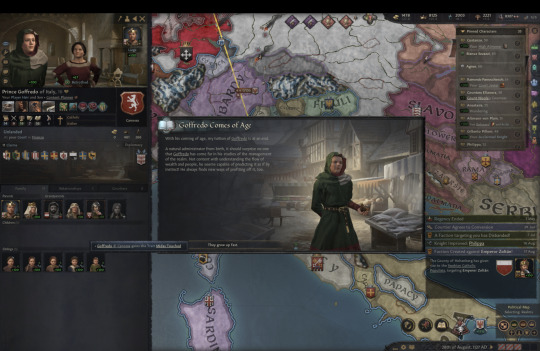
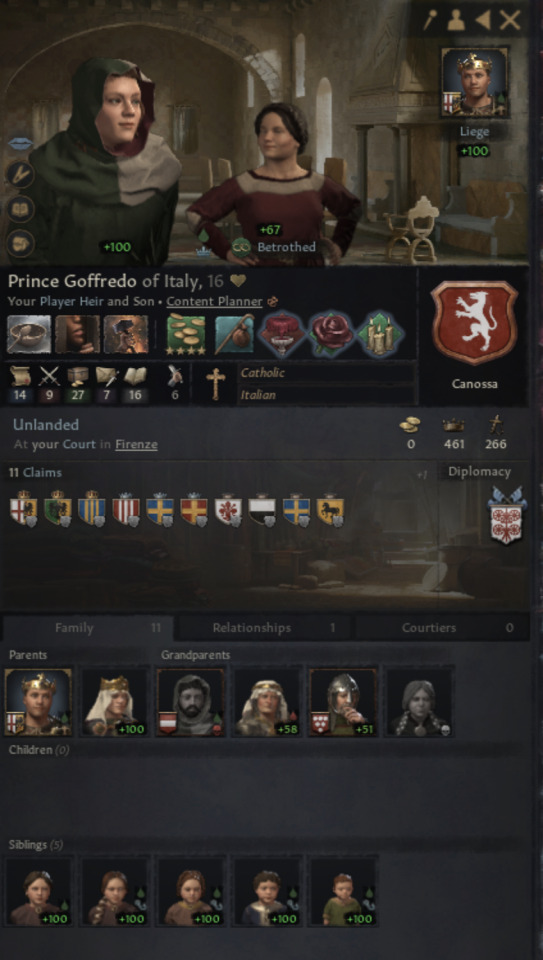
Soon, Prince Goffredo comes of age and becomes a Midas Touched (Level 4 Stewardship education). Besides that, he is also a secret Homosexual.
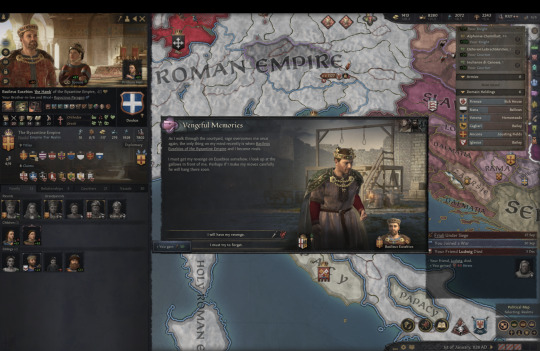
King Goffredo is beset with Vengeful Memories of how Basileus Eusebios of the Byzantine Empire abused his eldest sister Basilissa Anna. He contemplates making the man hang for his crimes as he gazes upon the gallows.
However, King Goffredo checks himself. God teaches us to forgive our neighbours and enemies for their trespasses against us, just as God forgives us of our trespasses. The fleeting thought of revenge passes from his mind.

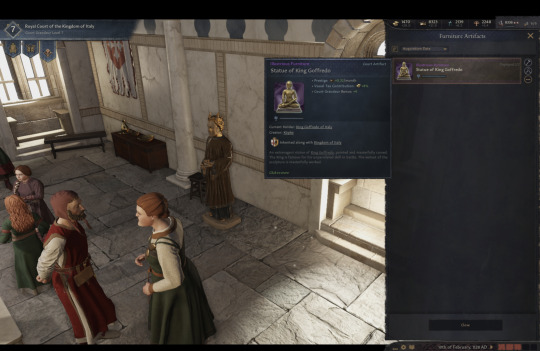
King Goffredo's beneficiary Kopke, crafts an Illustrious Furniture which he names "Kopke's Statue". King Goffredo renames it as "Statue of King Goffredo", because that is what the statue depicts.
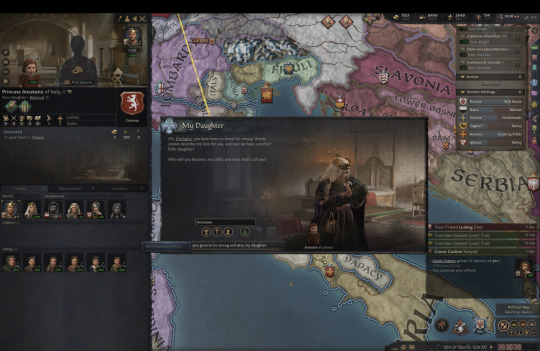
Queen Drichglur gives birth to their 4th daughter, Princess Anastasia of Italy, who is Comely and Intelligent.
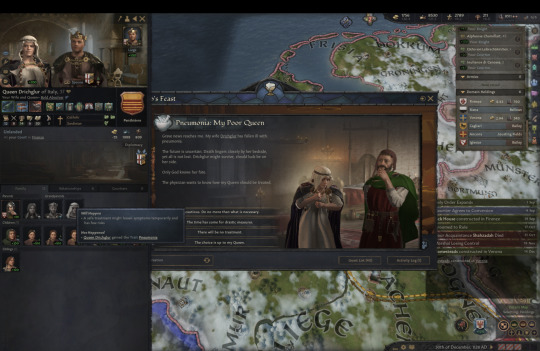

Within the span of 6 months, Queen Drichglur contracts Pneumonia, is given a safe treatment which is successful and recovers from Pneumonia in June of 1129.
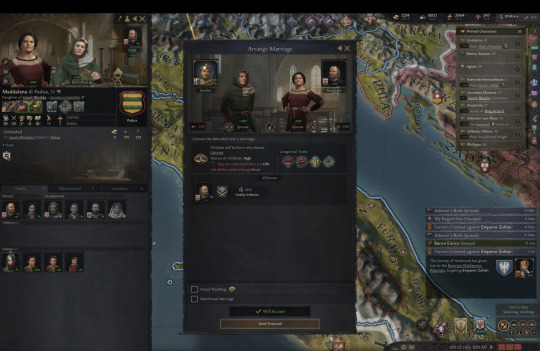
Soon, Maddalena di Padua, the daughter of Count Rinaldo, who is Amazonian, marries Prince Goffredo. With their union, their child has the chance of inheriting Beautiful, Intelligent, Herculean/Amazonian and Bleeder traits. This is on top of a 1.9% risk of their children being Inbred.

Finally, for his last Hold Court event, King Goffredo commissions the building of the City of Asciano in the County of Siena at the behest of his Steward, Count Eugenio of Polesine.
The construction would take 5 years to complete however, and we won't be playing King Goffredo in this file anymore. Thus concludes the adventures of King Goffredo and his grandmother Queen Matilda (formerly Duchess Matilda).
In the next post update, we will be playing Roads to Power DLC, with a brand new starting character! Let's look forward to it!
2 notes
·
View notes
Text
"Explore Turkey with Ease: A Complete Travel Guide for Armenian Citizens – Must-See Places, Tasty Food & Turkey eVisa Tips"
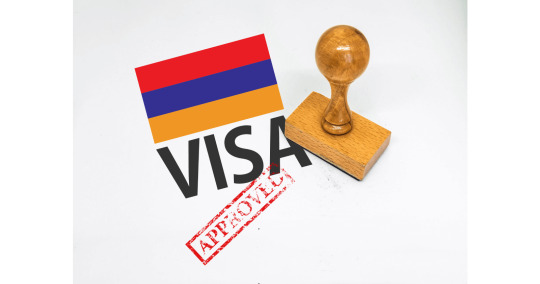
Turkey, a land where East meets West, offers an unforgettable experience with its rich history, stunning landscapes, and mouth-watering cuisine. For Armenian citizens, exploring Turkey has become easier than ever, thanks to the streamlined process of obtaining a Turkey eVisa for Armenian citizens. In this comprehensive guide, we’ll explore the most famous places to visit in Turkey, the must-try Turkish dishes, and how you can easily apply for the Turkey eVisa for Armenian citizens.
1. Istanbul: The Ultimate Gateway to Turkey
Istanbul, a city straddling two continents, is one of Turkey’s most iconic destinations. With its mesmerizing mix of cultural heritage, historical landmarks, and vibrant street life, Istanbul is an essential part of any trip to Turkey. For Armenian citizens looking to get a first glimpse of Turkey, Istanbul is the perfect starting point.
Hagia Sophia: This former church-turned-mosque is a masterpiece of Byzantine architecture. It’s one of Istanbul's most visited landmarks, and it’s easy to see why.
Topkapi Palace: Explore the grandeur of the Ottoman Empire with a visit to Topkapi Palace, the former residence of the Ottoman sultans.
Grand Bazaar: As one of the oldest and largest covered markets in the world, the Grand Bazaar is a shopper's paradise. Whether you’re looking for spices, carpets, or jewelry, this bustling market is the place to be.
As an Armenian citizen, don’t forget that obtaining a Turkey eVisa for Armenian citizens is quick and simple, and it will allow you to explore these iconic landmarks with ease.
2. Cappadocia: Nature’s Fairytale Land
Cappadocia’s surreal landscapes, with its fairy chimneys and cave dwellings, make it a must-visit region in Turkey. For Armenian citizens, exploring the unique beauty of Cappadocia is a trip worth making.
Hot Air Balloon Rides: A hot air balloon ride over Cappadocia’s stunning landscape is one of the most magical experiences in Turkey. It’s an adventure that should not be missed!
Göreme National Park: Famous for its ancient cave churches and rock-cut dwellings, this UNESCO World Heritage site is a must-see for history and culture lovers.
Underground Cities: Cappadocia is home to several ancient underground cities that were used as shelters during times of invasion. Visiting these subterranean marvels is a fascinating journey into the past.
As Armenian citizens, you can quickly obtain your Turkey eVisa online to begin your adventure in Cappadocia without hassle.
3. Pamukkale: A Natural Wonder
Pamukkale is a true natural wonder, and for Armenian citizens looking to experience Turkey’s beauty, this is an essential stop. The white terraces formed by thermal mineral waters create an almost otherworldly landscape.
Thermal Pools: Pamukkale’s hot springs have been attracting visitors for centuries. Take a dip in the mineral-rich waters and enjoy the therapeutic benefits.
Hierapolis Ancient City: At the top of the terraces, you’ll find the ancient city of Hierapolis. Explore the ruins, including a well-preserved Roman theater and ancient baths.
Traveling to Pamukkale is easy for Armenian citizens thanks to the Turkey eVisa for Armenian citizens, which simplifies the visa application process.
4. Antalya: The Mediterranean Gem
Antalya, situated on Turkey’s stunning Mediterranean coast, is a favorite among travelers for its beautiful beaches, ancient ruins, and welcoming atmosphere. Armenian citizens visiting Turkey will find Antalya a perfect blend of relaxation and history.
Kaleiçi (Old Town): The charming streets of Antalya’s Old Town are lined with historic buildings, Roman gates, and scenic courtyards. It’s the perfect place to soak in the city’s history.
Düden Waterfalls: Escape to nature with a visit to the Düden Waterfalls, a beautiful natural site just outside of Antalya.
Hadrian’s Gate: A monument to the city’s Roman past, Hadrian’s Gate is an architectural marvel and a must-see attraction.
Armenian citizens can easily secure their Turkey eVisa and begin their Turkish journey in Antalya without any travel complications.
5. Turkish Cuisine: A Culinary Adventure Awaits
When it comes to food, Turkey is a paradise. Whether you’re savoring kebabs, sampling mezes, or indulging in sweet baklava, Turkish cuisine offers something for every palate. Armenian citizens will be delighted to experience the full range of Turkish flavors.
Kebabs: From the spicy Adana kebab to the grilled shish kebab, Turkish kebabs are world-famous for their taste and quality.
Mezes: Turkish mezes (small appetizers) are the perfect way to sample a variety of flavors. Don’t miss hummus, baba ghanoush, and a variety of pickled vegetables.
Baklava: No visit to Turkey is complete without trying baklava, the sweet pastry made of layers of filo dough, nuts, and syrup.
Pide: Often referred to as Turkish pizza, pide is a delicious flatbread topped with cheese, minced meat, and vegetables.
Turkish Delight: A classic treat, Turkish Delight (lokum) is a sweet, chewy candy made from sugar, starch, and various flavorings like rose, lemon, and pistachio.
For Armenian citizens planning to visit Turkey and experience its culinary delights, the Turkey eVisa for Armenian citizens ensures a smooth entry into the country to enjoy these delicious dishes.
6. How Armenian Citizens Can Easily Apply for a Turkey eVisa
For Armenian citizens looking to visit Turkey, applying for the Turkey eVisa is an efficient and straightforward process. Forget the hassle of embassy visits or long queues – the Turkey eVisa for Armenian citizens allows you to apply online and receive your visa without leaving home.
Step 1: Visit the eVisa Portal: Go to the Turkey eVisa website and select Armenia as your country of citizenship.
Step 2: Fill Out the Application: Complete the online application form with your details, including your passport information and travel plans. Ensure accuracy to avoid delays.
Step 3: Pay the Visa Fee: After completing the form, you’ll need to pay the eVisa fee using your credit or debit card.
Step 4: Receive Your eVisa: Once your application is approved, you’ll receive your eVisa via email. Simply print it out or store it on your phone for easy access when entering Turkey.
Thanks to the Turkey eVisa for Armenian citizens, obtaining your visa has never been easier, allowing you to focus on planning your exciting Turkish adventure.
1 note
·
View note
Text
7 Incredible Things to Do in Istanbul 🇹🇷 Istanbul Travel Guide 2025 You Can’t Miss
Most travelers find Istanbul to be an extraordinary blend of rich history and vibrant culture. Whether you're wandering through majestic landmarks like the Hagia Sophia or savoring delicious local dishes, there's an abundance of unforgettable experiences awaiting you. This guide will help you discover the top attractions and activities that make Istanbul a must-visit destination in 2025. Get ready to explore your way through this enchanting city! Incredible Landmarks to Explore Your journey through Istanbul will be a vibrant tapestry of history and culture, woven together by its stunning landmarks. From majestic palaces to magnificent mosques, each site tells a unique story that captures the essence of this enchanting city. Embrace the opportunity to explore these remarkable attractions that have stood the test of time and continue to mesmerize visitors from around the globe. Hagia Sophia

Some say that visiting Istanbul without seeing the Hagia Sophia is like missing the heart of the city. Once a church, then a mosque, and now a museum, this architectural marvel showcases a breathtaking blend of Byzantine and Ottoman design. Its vast dome and exquisite mosaics leave you in awe, making it a must-see on your itinerary. Topkapi Palace

Some visitors to Istanbul find themselves enchanted by the Topkapi Palace, the former residence of the Ottoman sultans. This sprawling complex offers a glimpse into the opulence of royal life, with its beautifully designed courtyards, lavish rooms, and impressive collections of artifacts. The stunning views over the Bosphorus add to the palace's charm, making it a perfect spot for taking memorable photos. With its rich history, the Topkapi Palace transports you back to the days of sultans and empires. You can explore the Harem, where the royal family lived, and wander through the treasure room, which holds an incredible collection of jewels and relics. You'll also enjoy panoramic views of the Bosphorus Strait, perfect for appreciating the strategic importance of this grand palace. Basilica Cistern
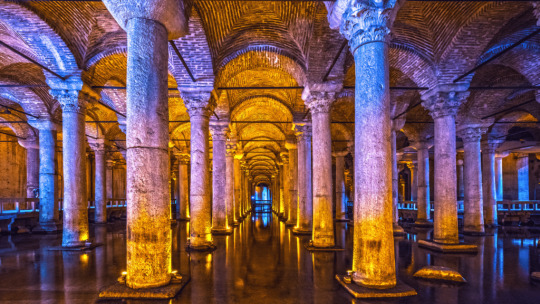
Explore the enchanting depths of the Basilica Cistern, an ancient underground reservoir that dates back to the 6th century. As you descend into this atmospheric space, you'll be greeted by rows of glowing columns and the gentle sound of dripping water, offering a serene escape from the bustling streets above. For instance, within the Basilica Cistern, you'll discover Medusa's head, one of many intriguing features. This ancient marvel was built to supply water to the Great Palace of Constantinople and showcases incredible engineering skills. The eerie ambiance combined with its historical significance makes it a unique experience that you won't want to miss in your Istanbul adventure. Enchanting Markets The vibrant markets of Istanbul are a treasure trove of culture, color, and commerce, inviting you to immerse yourself in the local way of life. These bustling hubs not only offer unique shopping experiences but also provide a glimpse into the traditions and history of this magnificent city. From handicrafts to spices, the markets are an vital part of your Istanbul journey. The Grand Bazaar The Grand Bazaar is a must-visit landmark, boasting over 4,000 shops and a history that spans nearly six centuries. As you wander through its maze-like alleys, you'll discover everything from handmade carpets and intricate jewelry to ceramics and textiles. Be sure to haggle; it's part of the experience, and you might snag a fantastic deal! Spice Bazaar

Any visit to Istanbul would be incomplete without exploring the Spice Bazaar, also known as the Egyptian Bazaar. Here, you'll be greeted by the fragrant scents of exotic spices, dried fruits, and traditional sweets. This historical market dates back to the 17th century and is a sensory overload of vibrant colors and aromatic delights. Another highlight of the Spice Bazaar is the chance to sample locally sourced products such as Turkish delight and pistachio baklava, which are both irresistible treats. As you stroll through the stalls, don't miss out on the opportunity to chat with local vendors who are eager to share their knowledge about the spices and products they sell. Just be cautious as it can get quite crowded, especially during peak tourist seasons, and keep a close eye on your belongings to ensure a worry-free shopping experience! https://youtu.be/-pWc6EfgM-U Cultural Experiences All around Istanbul, a rich tapestry of cultural experiences awaits you that reflects the city's unique blend of history and modernity. From the serene ambiance of ancient mosques to vibrant bazaars, every corner offers a glimpse into the local lifestyle and traditions. Engaging with locals in these settings allows you to immerse yourself in the diverse narratives that shape this mesmerizing city. Don't miss out on these experiences that truly capture the essence of Istanbul. Traditional Turkish Bath
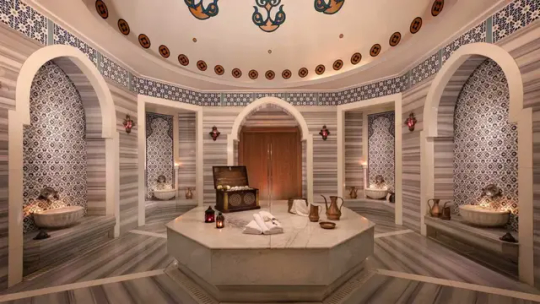
There's something undeniably rejuvenating about a visit to a traditional Turkish bath, or hamam. As you step inside, you're greeted by the soothing sounds of warm water and the fragrant aroma of vital oils. Expect to indulge in a ritual of cleansing and relaxation, where skilled attendants provide a scrubbing service known as kese, followed by a foam massage. This experience not only washes away your day's stress but also connects you to the customs that have been cherished for centuries. Whirling Dervishes Show

Dervishes captivate audiences with their spiritual dance, a mesmerizing display that symbolizes the quest for divine love and enlightenment. As you watch the swirling figures clad in flowing garments, you'll be transported to a state of tranquility and introspection. The show, often accompanied by live music, highlights a unique aspect of Turkish culture that blends art and spirituality, allowing you to see the passion and dedication behind this ancient tradition. Bath houses have long been a staple of Turkish culture, but the allure of the Whirling Dervishes Show runs even deeper. This performance is not just a feast for the eyes; it's a profound journey of the soul. The dervishes spin rhythmically, achieving a state of spiritual ecstasy that reflects their devotion. This transformative experience captivates hundreds of visitors every week, illustrating the enduring significance of this ancient Sufi tradition. As you absorb the ambiance, you'll feel a connection to the roots of Istanbul, showcasing a remarkable blend of art, spirituality, and heritage. Gastronomic Delights Many travelers find that the culinary experience in Istanbul is a journey worth taking. From the bustling street vendors to the elegant restaurants, the city is filled with flavors that tell stories of culture and history. Dive into a multitude of dishes that reflect the city's rich heritage, whether you prefer sitting down for a leisurely meal or grabbing a quick bite while exploring. Must-Try Local Dishes To fully appreciate Istanbul, you must indulge in its iconic local dishes. Start your culinary adventure with Kebabs, including the world-famous doner kebab, and savor the rich flavors of Lahmacun, often described as Turkish pizza. Don't miss out on Meze—small dishes that are perfect for sharing, ranging from creamy hummus to stuffed grape leaves that provide an unforgettable taste of region.


Street Food Essentials You'll find that Istanbul's street food scene is vibrant and diverse, offering a quick and delicious way to experience local flavors. One of the must-try items is Simit, a sesame-covered bread ring that is crunchy on the outside and soft inside. Another delightful treat is Kumpir, a loaded baked potato filled with a variety of toppings. For those with a sweet tooth, indulge in Baklava, layers of pastry filled with nuts and sweet syrup that provides a perfect ending to your street food adventure.



Dishes served from street carts and small stalls are not just affordable; they embody the spirit of Istanbul. The food is often prepared right before your eyes, offering a sense of authenticity that restaurants can't always capture. Try out Balık Ekmek (fish sandwiches) near the Galata Bridge, where freshly caught fish is grilled to perfection. You'll discover that the flavors are just as incredible as the atmosphere—lively, bustling, and aromatic. Just be sure to choose a stall with a line, indicating the food is both popular and fresh! Scenic Views and Outdoors For a mesmerizing experience in Istanbul, be sure to explore the city's breathtaking scenic views and outdoor attractions. With a rich blend of natural beauty and historic architecture, you'll find numerous vantage points that offer unparalleled perspectives of the city's iconic skyline and landmarks. From serene parks to bustling waterfronts, the outdoor experiences in Istanbul are just waiting for you to discover. Bosphorus Cruise To truly appreciate the stunning beauty of Istanbul, initiate on a Bosphorus cruise. This unique experience allows you to sail between two continents while soaking in panoramic views of the city's skyline, Ottoman palaces, and charming villages that line the strait. As you glide along the water, you'll find yourself captivated by the scenic beauty that defines this remarkable city. Galata Tower

Galata tower. Istanbul city landscape aerial view To gain a truly spectacular view of Istanbul, visit the historic Galata Tower. This medieval stone edifice offers one of the best panoramas of the city, providing a 360-degree snapshot of iconic sites such as the Hagia Sophia and the Golden Horn. Climbing to the top is an exhilarating experience, as you navigate your way through the circular staircase, ultimately rewarded with a breathtaking vista. Understanding the Galata Tower is necessary for any visitor. Standing tall at 66.9 meters, this tower has been a vital symbol of Istanbul for centuries. It dates back to the 14th century and serves not just as a lookout point, but also as a reminder of the city's rich history. Be prepared for crowds during peak hours, as this popular attraction can be quite busy, but the views you'll experience from the top make it well worth the effort. Don't forget your camera to capture the stunning skyline and picturesque setting that make Istanbul truly unforgettable! Useful Tips for Tourists Keep your experience in Istanbul smooth and enjoyable by following these practical tips: Always have cash on hand, particularly in smaller markets. Learn a few basic phrases in Turkish; locals appreciate the effort. Dress modestly when visiting mosques and religious sites. Be cautious with street food; choose vendors that are busy and trustworthy. Use public transportation to avoid traffic and enjoy the scenery. You will find these tips invaluable as you explore the enchanting city.

Get your free luggage tags: https://buff.ly/4aekjm2 Transportation Options Transportation in Istanbul is both comprehensive and convenient. You can navigate the city using the metro, tram, and ferry systems, which connect major attractions efficiently. Taxis are available, but ensure that they use the meter to avoid overcharging. For a more scenic experience, consider taking a ferry on the Bosphorus—it's affordable and offers stunning views of the city's skyline. Cultural Etiquette While visiting Istanbul, being aware of local customs can enhance your experience. Greet people with a friendly smile and a polite handshake to show respect. It's considered rude to enter someone's home with shoes on, so be prepared to remove them when invited inside. When dining, wait for the host to start or signal to begin, and remember to use your right hand for eating and passing food, as the left hand may be considered impolite. Plus, it's best to avoid public displays of affection, as they might not be well-received in more conservative areas. Always ask for permission before photographing locals, as some may find it intrusive. Learning about and respecting these cultural norms will help you connect with people and enjoy your trip to its fullest.
Recommendations for Your Stay
Finding the perfect place to stay in Istanbul can elevate your travel experience. Here are some budget-friendly and luxury hotel options to suit different travelers' needs. Budget-Friendly HotelsLuxury HotelsSultanahmet SuitesFour Seasons Hotel IstanbulCheers HostelCiragan Palace KempinskiSuite 6 HotelRaffles Istanbul Budget-Friendly Hotels - Sultanahmet Suites: This charming hotel is located in the historic Sultanahmet district, making it easy to explore the main attractions. Book a room in Sultanahmet suites: https://buff.ly/mZm8BIV - Cheers Hostel: Perfect for solo travelers and backpackers, this cheerful hostel offers a friendly atmosphere and is situated close to the Grand Bazaar. Book a room in Cheers Hostel: https://buff.ly/m8p1KIO - Suite 6 Hotel Conveniently located in the center of Istanbul, Suite 6 Hotel is within a 5-minute walk of Istiklal Street and 500 yards of Taksim Square. The property is located 1.2 miles from Dolmabahce Clock Tower, 1.8 miles from Dolmabahce Palace and 2.3 miles from Spice Bazaar. Book a room in Suite 6 Hotel: https://buff.ly/1HCYqO9

Sultanahmet Suites

Cheers Hostel

Suite 6 Hotel Luxury Hotels - Four Seasons Hotel Istanbul: A luxurious oasis located in the historic Sultanahmet area, boasting exceptional service and stunning views. Book a room in Four Season Hotel: https://buff.ly/FX277iS - Ciragan Palace Kempinski: A palace-turned-hotel on the Bosporus, this lavish accommodation offers opulent rooms and outstanding amenities. Book a room in Ciragan Palace Kempinski: https://buff.ly/ZrwrIKh - Raffles Istanbul: Modern and centrally located, Raffles offers top-notch luxury with a contemporary twist, including a world-class spa. Book a room in Raffles Istanbul: https://buff.ly/0V4tE4X

Four Season Hotel

Ciragan Palace Kempinski

Raffles Istanbul
Tips for Tourists
- Get an Istanbulkart: This travel card makes public transportation seamless and economical. Use it for buses, trams, trolleys, and ferries. - Dress Respectfully: When visiting mosques, adhere to appropriate dress codes—women should cover their hair, and both men and women should wear long pants or skirts. - Practice Basic Turkish: Knowing a few phrases in Turkish can enrich your interactions with locals and show appreciation for the culture. - Explore Neighborhoods: Don't just stick to the tourist spots; neighborhoods like Balat and Kadikoy offer authentic experiences and incredible dining options. Final Words Considering all points, your journey to Istanbul will be unforgettable with the 7 incredible things you can do. From exploring the majestic Hagia Sophia to indulging in local delicacies at bustling street markets, the city offers a blend of history, culture, and gastronomy that captivates every traveler. Whether you're strolling along the Bosphorus or visiting the vibrant Grand Bazaar, each experience will leave a lasting impression. Make the most of your adventure in this enchanting city, and embrace the rich tapestry of sights and sounds that Istanbul has to offer. Istanbul is filled with countless experiences waiting to be uncovered. Step into its rich history, savor its incredible food, and explore its vibrant streets. If you want to stay updated with more travel tips, itineraries, and stories, make sure to subscribe to our YouTube channel for more engaging content!

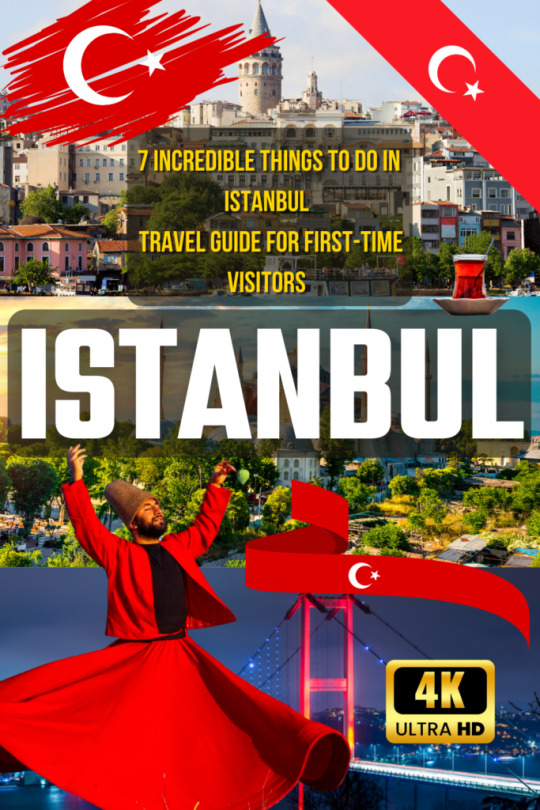
Read the full article
0 notes
Text
Exploring Istanbul's Must-See Landmarks
Discover Istanbul's rich history and vibrant culture through its must-see landmarks, including iconic sites like Hagia Sophia, Topkapi Palace, and the bustling Grand Bazaar, offering unforgettable experiences for every traveler
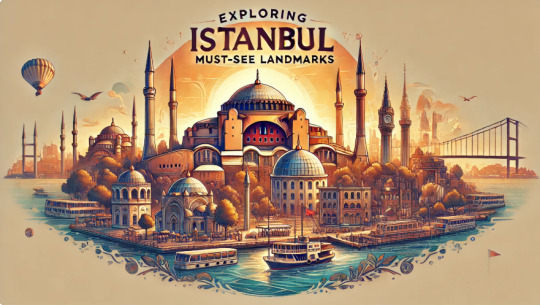
Craving an unforgettable adventure? Look no further than Istanbul, the captivating city that bridges Europe and Asia. With its rich history, vibrant culture, and stunning architecture, Istanbul is a must-visit destination for any traveller. Whether you're a history buff, a foodie, or simply seeking a unique experience, this cosmopolitan city has something to offer everyone. Get ready to be enchanted by Istanbul's allure and discover why it's quickly becoming one of the world's most sought-a
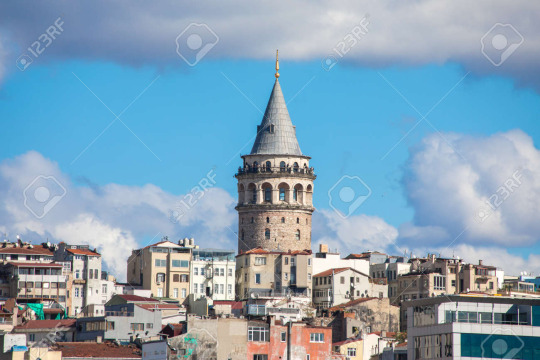
Explore these must-see places and activities to make the most of your Istanbul adventure.
Purchase an Istanbul Tourist Pass!
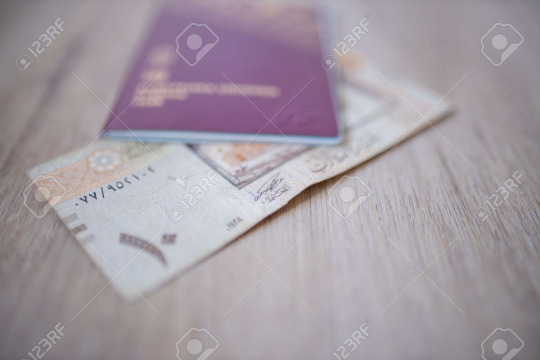
Tired of the hassle of buying individual tickets for each attraction in Istanbul? Look no further than the Istanbul Tourist Pass! This handy little card is your golden ticket to exploring the city's top sights without breaking the bank.
What does the pass offer?
Free entry: Access to over 100 popular attractions, including historical landmarks, museums, and cultural sites.
Flexibility: Choose a pass for 1 to 10 days to suit your travel plans.
VIP treatment: Skip the lines and enjoy priority access to many attractions.
Digital convenience: No need for paper tickets. Simply scan your phone to enter.
Transportation discounts: Some passes offer discounts on public transportation for added convenience.
Istanbul, Turkey, is a captivating blend of history, culture, and modernity. From the iconic Hagia Sophia to the bustling Grand Bazaar, the city offers endless exploration. When you visit Turkey Istanbul, immerse yourself in its vibrant streets, savor traditional Turkish cuisine, and witness stunning Bosphorus views for an unforgettable experience.
So, what are you waiting for? Grab an Istanbul Tourist Pass and start exploring this vibrant city like a local!
Visit Hagia Sophia: A Timeless Marvel of Istanbul
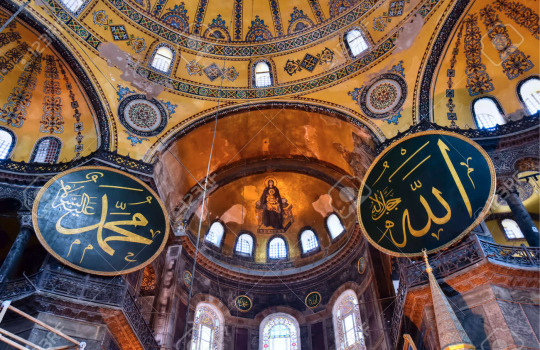
Hagia Sophia is undoubtedly one of the most iconic landmarks in Istanbul. This magnificent structure has witnessed centuries of history, serving as both a church and a mosque over the years.
Originally built in 360 AD, Hagia Sophia has undergone several reconstructions. The current building dates back to the 6th century and is a testament to Byzantine architectural brilliance. It served as a Greek Orthodox cathedral for nearly 900 years before being converted into a mosque during the Ottoman Empire. In 1934, it was transformed into a museum, attracting visitors from around the world.
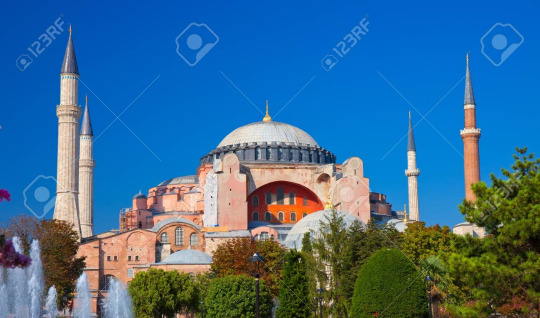
In 2020, a significant decision was made to reconvert Hagia Sophia into a mosque. This means that anyone, regardless of religion, can now visit and explore this historic site free of charge. While there may be temporary closures during prayer times, the mosque remains open to the public for most of the day.
Plan Your Visit:
Opening hours: Hagia Sophia is open daily from 9 AM to 10 PM.
Entrance fee: There is no longer an entrance fee as it is now a mosque.
The Blue Mosque: A Stunning Ottoman Gem
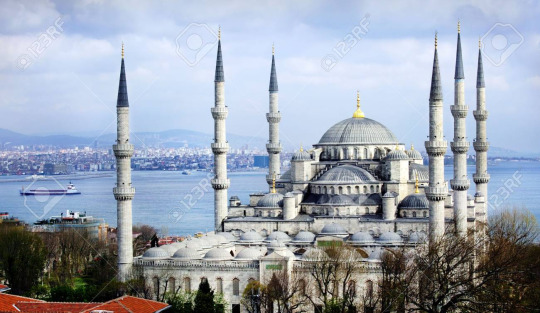
The Blue Mosque is a breathtaking example of Ottoman architecture and one of Istanbul's most popular tourist attractions. Known for its six minarets, this mosque continues to serve as an active place of worship and welcomes visitors worldwide.
Built between 1609 and 1616, the Blue Mosque is renowned for its intricate Iznik tiles, which give the interior its signature blue hue. Despite its popularity with tourists, it remains a functioning mosque, adhering to daily prayer times.
Tips for Visiting:
Opening hours: The mosque typically opens around 8:30 AM and closes for approximately 30 minutes during prayer times. Check the exact schedule posted outside the mosque.
Dress code: Adhere to a modest dress code. Women should cover their shoulders and knees. If you forget to bring a scarf, you can rent one from the kiosk in the garden.
Guided tours: Consider a guided tour, especially if you have an Istanbul Tourist Pass, to learn more about the mosque's history and architecture.
The Grand Bazaar: A Shopper's Paradise
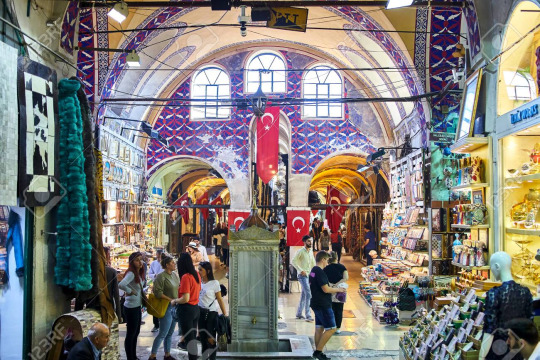
The Grand Bazaar, or "Kapalıçarşı," is a must-visit destination for any traveller in Istanbul. This historic marketplace offers a unique shopping experience with diverse goods and a captivating atmosphere.
Founded in the 15th century by Sultan Mehmed II, the Grand Bazaar has witnessed centuries of trade and commerce. Despite facing various challenges, including fires and earthquakes, it has endured and grown into one of the world's largest covered markets.
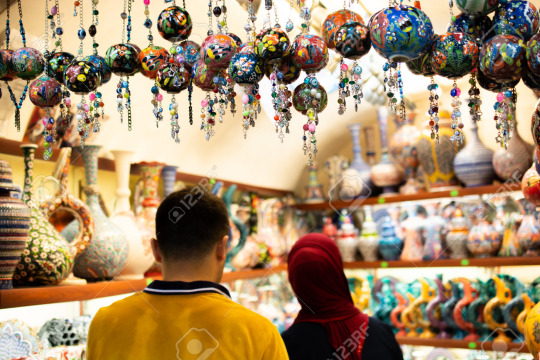
A Shopper's Dream:
With over 4,000 shops across 61 streets, the Grand Bazaar is a treasure trove for shoppers. From traditional Turkish handicrafts to modern-day souvenirs, you'll find something to suit every taste and budget.
Plan Your Visit:
Opening hours: The Grand Bazaar is open daily from 8:30 AM to 7 PM, except on Sundays and the first day of religious holidays.
Entrance fee: There is no entrance fee to the Grand Bazaar.
Ortaköy Mosque
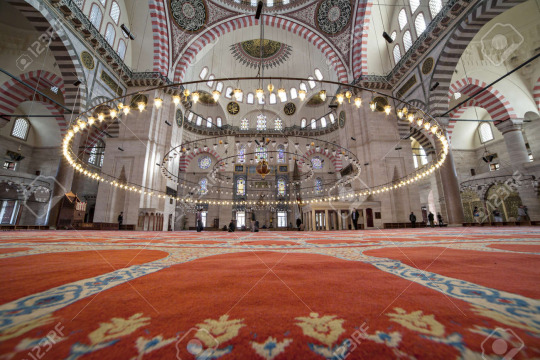
Ortaköy Mosque is a stunning architectural gem nestled along the Bosphorus Strait. Its unique design and picturesque location make it a must-visit for any traveller in Istanbul.
Designed by the same architect behind the renowned Dolmabahçe Palace, Ortaköy Mosque boasts a striking neo-Baroque style. Its white exterior and elegant minarets stand out against the backdrop of the Bosphorus.
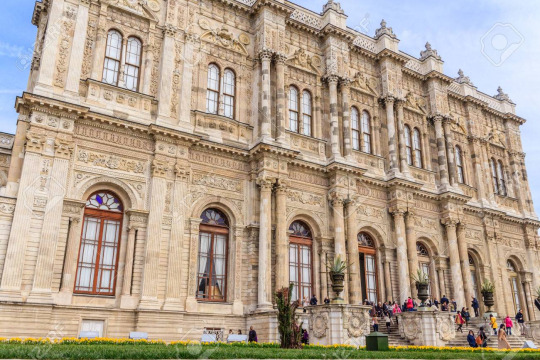
A Perfect Sunset Spot:
The mosque's location offers breathtaking views of the Bosphorus Bridge and the surrounding cityscape. It's an ideal spot to enjoy a leisurely stroll and watch the sunset over the water.
Ortaköy is a charming neighbourhood that has been transformed from a sleepy fishing village into a bustling hub of nightlife and dining. Discover trendy cafes, chic boutiques, and lively bars in the area.
Plan Your Visit:
Opening hours: Ortaköy Mosque is open daily from 4 AM to 10 PM.
Sura Hagia Sophia Hotel: Your Istanbul Oasis
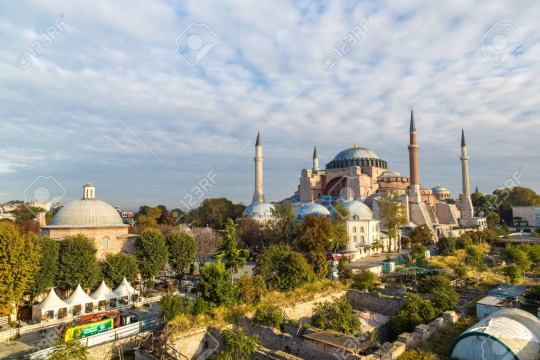
Sura Hagia Sophia Hotel is a luxurious haven nestled in the heart of Sultanahmet. It offers breathtaking views of Istanbul's iconic landmarks. With its historic charm and modern amenities, this hotel is the perfect choice for travellers seeking a memorable stay.
A Dreamy Location:
Nestled in the Sultanahmet district, the hotel offers stunning views of the Hagia Sophia and other historical sites. Its prime location puts you within walking distance of popular attractions like Sultanahmet Square, Topkapi Palace, and the Grand Bazaar.
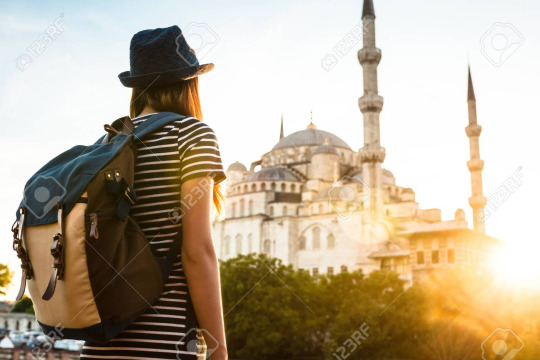
Luxurious Accommodations:
With 222 rooms, each designed in a unique style, the Sura Hagia Sophia offers a variety of accommodation options to suit your preferences. Indulge in the opulence of Ottoman palaces with a visit to the hotel's historical Ottoman Bath.
After a day of exploring the city, unwind at the Spa Soul, offering a range of relaxing treatments and massages.
Whether travelling solo, as a couple, or with family, the Sura Hagia Sophia Hotel provides a comfortable and unforgettable stay. Its prime location, luxurious amenities, and historical charm make it an ideal choice for those seeking to immerse themselves in Istanbul's rich culture.
Dolmabahçe Palace: A Symbol of Ottoman Opulence
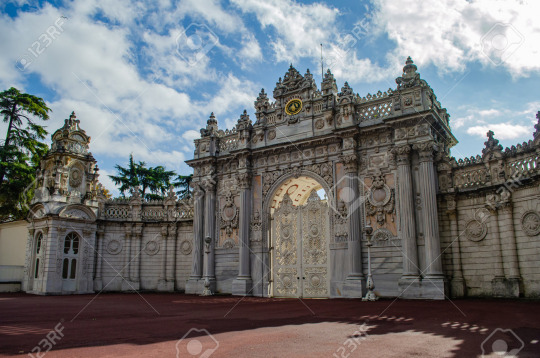
Dolmabahçe Palace is a stunning architectural masterpiece showcasing the Ottoman Empire's grandeur. Built in the European style, this palace was commissioned by Sultan Abdül Mecit in the 19th century.
Despite its opulent appearance, the palace's construction was motivated by a desire to mask the decline of the Ottoman Empire. With its 285 rooms, 44 halls, and numerous bathrooms, Dolmabahçe Palace is a testament to the empire's former glory.
To ensure a memorable visit, arrive early in the morning as the palace has a daily visitor limit of 3,000. Consider purchasing tickets online in advance to avoid long queues.
Opening hours: 9 AM to 5:30 PM (closed on Mondays)
Entrance fee: 650TRY (includes audio guide) Or included in the Istanbul Tourist Pass.
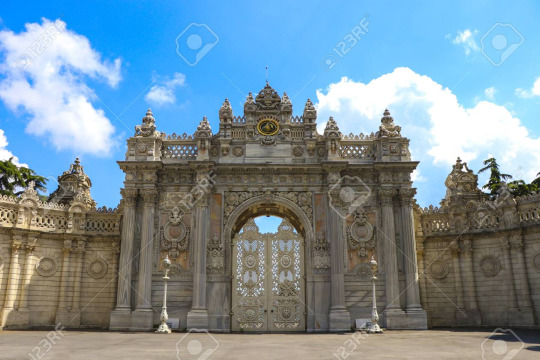
Explore the Palace:
Start your visit by exploring the beautiful Palace Gardens, where you can take photos and enjoy the peaceful surroundings. Inside the palace, admire the intricate details of the interior and learn about the history of the Ottoman Empire.
Galata Tower: A Timeless Icon of Istanbul
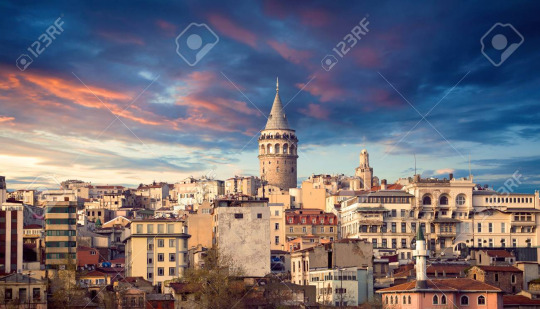
Galata Tower is a historic landmark that has stood tall over Istanbul for centuries. Originally built as a watchtower, it has served various purposes throughout its history, from prison to observatory.
Today, Galata Tower offers visitors breathtaking views of the city's skyline. Climb to the top and admire the stunning panorama of the Golden Horn, the Bosphorus Strait, and the historic Sultanahmet district.
With its rich history and architectural significance, Galata Tower is a must-visit attraction for anyone exploring Istanbul.
Opening hours: 8:30 AM to 11 PM
Entrance fee: 650TRY (or included in the Istanbul Tourist Pass)
Balat: A Vibrant Neighborhood of Colors and History
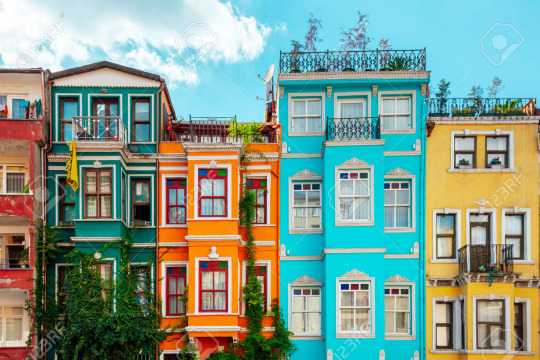
Balat is a charming district in Istanbul known for its colourful houses, cobblestone streets, and diverse religious heritage.
A Kaleidoscope of Colors:
Balat's most striking feature is its vibrant array of colours. The district's historic wooden houses, many of which date back centuries, are painted in various hues, creating a picturesque scene.
Balat has a rich cultural heritage, combining synagogues, mosques, and churches. This diversity reflects the district's history as a home to various minority groups.
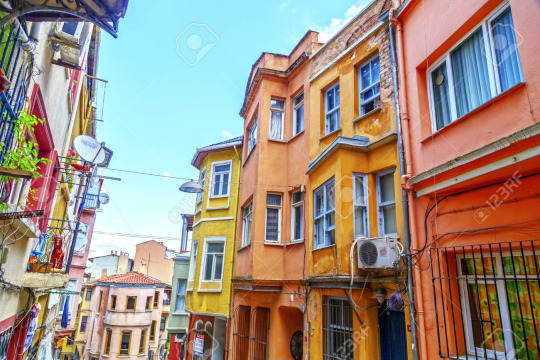
In recent years, Balat has become a popular destination for young locals and tourists. The district is now home to trendy cafes, bars, and shops, offering a vibrant atmosphere.
Take your time to wander through Balat's narrow streets, exploring its hidden gems and admiring the colourful architecture. Be prepared for some steep inclines, but the views and unique atmosphere are well worth the effort.
Suleymaniye Mosque: A Monument to Ottoman Grandeur
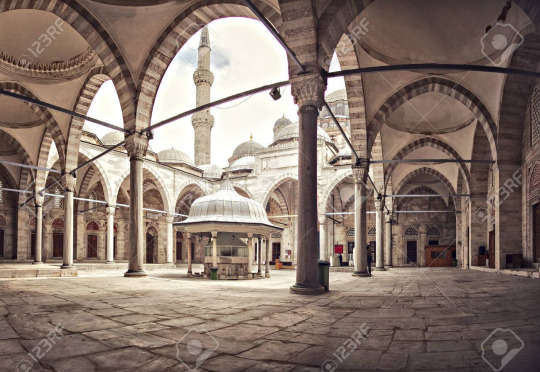
Suleymaniye Mosque stands proudly atop Istanbul's third hill, a testament to the Ottoman Empire's architectural mastery. This magnificent mosque was commissioned by Sultan Suleiman the Magnificent, one of the most powerful rulers in Ottoman history.
Beyond its religious significance, Suleymaniye Mosque served as a symbol of Sultan Suleiman's power and influence. Its construction showcased the empire's artistic and architectural prowess at its peak.
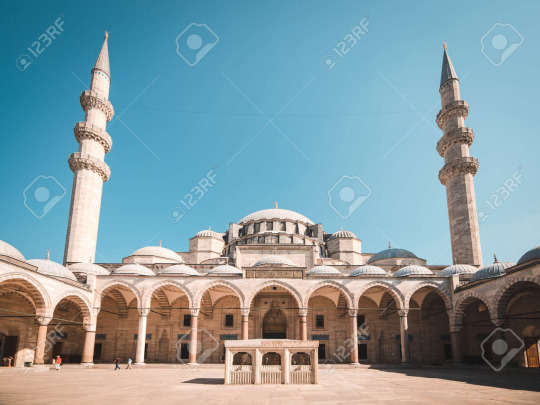
Despite facing various challenges throughout its history, Suleymaniye Mosque has endured and been lovingly restored. The mosque's interior is adorned with intricate Iznik tiles, stained glass windows, and calligraphy, creating a serene and inspiring atmosphere.
The Suleymaniye Mosque complex also includes a library, a school, and the tombs of Sultan Suleiman and his wife, Roxelana. This historical site offers visitors a glimpse into Istanbul's rich heritage.
Plan Your Visit:
Opening hours: 9 AM to 5 PM
Entrance fee: Free
Maiden's Tower: A Romantic Sunset Spot
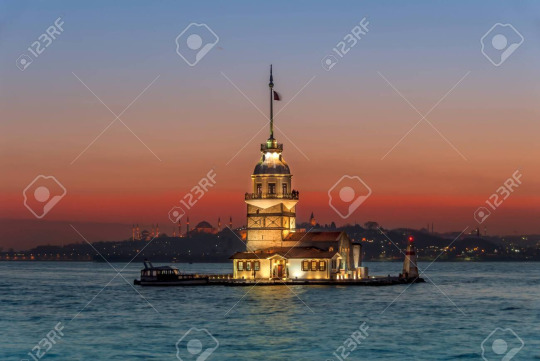
Maiden's Tower is a picturesque landmark on Istanbul's Asian side. It's a popular destination for couples seeking a romantic and unforgettable experience.
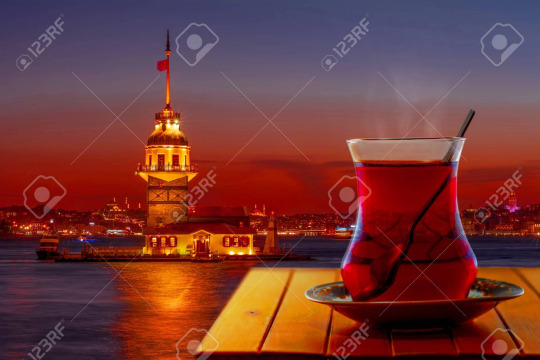
A Sunset to Remember:
Watching the sunset from Maiden's Tower is a magical experience. As the sun dips below the horizon, casting a golden glow over the city, you'll be treated to a breathtaking view of the Bosphorus Strait.
Tips for Your Visit:
Arrive early: To secure a good spot, arrive at least an hour before sunset.
Enjoy Turkish tea and pretzels: Enhance your experience by indulging in traditional Turkish tea and pretzels.
Consider the Istanbul Tourist Pass: The pass includes a Maiden's Tower Audio Guide and a two-way boat transfer.
Spice Bazaar: A Sensory Delight
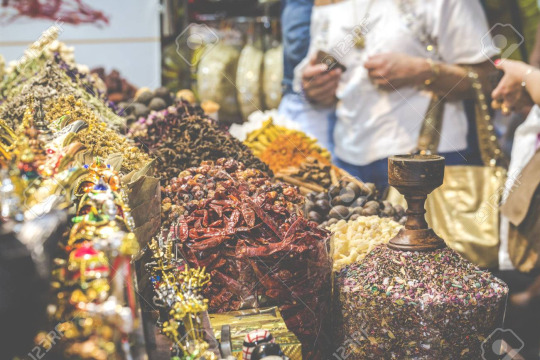
The Spice Bazaar is a vibrant and aromatic destination in Istanbul that offers a unique shopping experience. While it may not be as famous as the Grand Bazaar, it's certainly worth a visit for its unique charm and diverse selection of spices.
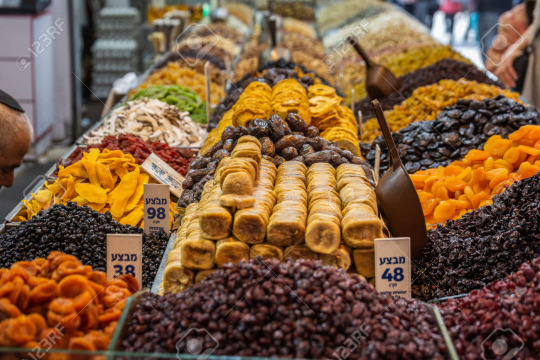
A Sensory Overload:
As you wander the Spice Bazaar, you'll be greeted by a symphony of scents and flavours. From the pungent aroma of chilli peppers to the delicate fragrance of saffron, there's something to tantalize every taste bud.
The Spice Bazaar is the perfect place to stock up on authentic Turkish spices. Some popular options include:
Sumac: A tangy spice often used in salads and grilled meats.
Pul Biber: A red pepper flake used to add heat to dishes.
Nar Eksisi: A pomegranate molasses used as a sweetener and flavouring.
Cörek otu: A nigella seed used in bread and pastries.
Saffron: A precious spice known for its vibrant colour and unique flavour.
Whether you're a seasoned cook or simply looking for a unique souvenir, the Spice Bazaar offers a memorable experience.
Topkapi Palace: A Journey Through Ottoman History
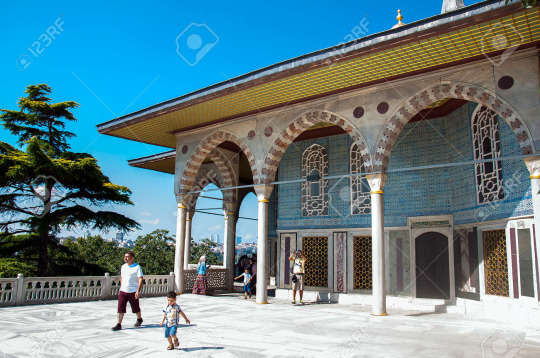
Topkapi Palace is a must-visit destination for anyone exploring Istanbul. This magnificent palace served as the centre of the Ottoman Empire for centuries and offers a fascinating glimpse into the city's royal past.
As you wander through the palace's lavish courtyards and rooms, you'll be transported to an era of unparalleled opulence. Discover the stories of sultans, concubines, and court intrigue that unfolded within these walls.

Topkapi Palace houses a vast collection of treasures, including the Prophet Muhammad's cloak and sword, as well as a dazzling array of jewels and artifacts. Explore the Imperial Harem and learn about the private lives of the sultans and their families.
End your visit with a stroll through the palace gardens, where you'll be rewarded with panoramic views of Istanbul.
Plan Your Visit:
Opening hours: 9 AM to 6 PM (closed on Tuesdays)
Entrance fee: 750TRY (includes Hagia Irene Museum and audio guide). Guided Topkapi Palace Museum Tour is also included in the Istanbul Tourist Pass
Rainbow Street: A Vibrant Corner of Karaköy

Rainbow Street, officially known as Hoca Tahsin Street, is a colourful and charming pedestrian street in Istanbul's Karaköy neighbourhood. This vibrant street offers a glimpse into the city's modern and artistic side.
Rainbow Street is known for its colourful facades and trendy atmosphere. It's a great place to explore, soak up the local vibe, and discover hidden gems.

Cafés, Art, and Cuisine:
The street is lined with cafes, art galleries, and restaurants, offering something for everyone. Enjoy a delicious meal, sip coffee, and admire the local art scene.
Enjoy Your Istanbul Adventure!
With careful planning and a little research, you can experience Istanbul's magic on a budget. Whether you're exploring historical landmarks, indulging in delicious cuisine, or simply soaking up the city's vibrant atmosphere, Istanbul will leave a lasting impression.
#travel#travelling#touristpassofistanbul#advantureofIstanbul#placesofIstanbul#Istanbultouristplaces#turkeyIstanbul#istanbul#turkey
0 notes